5 Ways To Raise Your Law Firm’s Profit Margin
5 Ways To Raise Your Law Firm's Profit Margin
How much money does your firm actually keep after paying for everything: staff, rent, tech, marketing, and coffee? That’s your profit margin, and it’s one of the most important numbers in your business.
Many lawyers look at gross revenue and assume they’re doing well. But if your operating expenses keep growing, that top-line number doesn’t tell the full story. Profit margin shows how efficient your firm really is, not just how busy it looks from the outside.
In this guide, we’ll break down what profit margin means for law firms, what a healthy range looks like, and how to raise it without burning out your team.
You’ll learn how to cut out the work that’s dragging you down, bring in better clients, and use the right tools to free up your time.

The Role of Profit Margin In Law Firm Profitability
Profit margin shows how much your firm keeps after paying all expenses. It’s one of the clearest ways to measure how well your business is doing financially.
Here’s the basic formula:
(Total Profit ÷ Total Revenue) × 100 = Profit Margin
For example, if your firm brings in $500,000 in revenue and spends $350,000 on salaries, rent, software, and other costs, your profit is $150,000. That gives you a 30% profit margin.
This metric helps you understand where your money’s going and whether your firm is running efficiently. A strong margin means you’re making good use of your time, staff, and resources. A weak one points to issues like high overhead, low productivity, or poor pricing.
Keeping an eye on this number helps you figure out if you’re pricing your services right, managing overhead well, or losing money on unproductive work.
What’s The Ideal Profit Margin For Law Firms?
Most small law firms aim for a profit margin between 25% and 35%, according to Irvine Bookkeeping. Falling below that range could be a sign that something’s off—maybe your overhead’s too high, or you’re spending too much time on non-billable work.
On the flip side, if your margin’s above 35%, that usually means your firm runs lean, prices smartly, and manages time well.
But it’s not always about being high or low. Your priority should be staying sustainable. A smaller firm with less overhead might hit a higher margin, while larger firms might accept slimmer ones due to scale.
The key is knowing your own numbers. If you’re consistently under 20%, it’s time to look at where the money’s going. Tightening up processes, improving time tracking, and pricing your services properly can push your margin in the right direction without adding more stress to your day.

Best Strategies To Increase Your Average Profit Margin
If your profit margin isn’t where you want it to be, the good news is you can fix it. It’s often less about working more and more about working smarter.
Here are some practical strategies to help raise your average profit margin without burning out your team or cutting corners.
1. Automate The Tasks Costing You Money
A successful law firm doesn’t waste time on repetitive work that doesn’t bring in revenue. Most law firms lose money every month by having staff spend hours on tasks that could be handled automatically. These small inefficiencies add up and eat into your profit margin without you even noticing.
If you’re aiming for higher profit margins, you need to take a closer look at your daily operations. Many parts of your workflow, regardless of your practice area, can be automated to reduce time and cut costs.
This helps you improve your cost structure while freeing up your team for billable work and client acquisition. Here are common tasks you can automate:
- Appointment scheduling with automated calendar links
- Invoice creation and payment reminders
- Document automation for contracts, letters, discovery documents, and more
- Client intake using online forms and auto-responses
- Follow-up emails after consultations or completed cases
- Time tracking and billing entries
- Data entry into case management systems
By automating these tasks, you reduce errors, speed up your workflow, and keep your team focused on legal work. Most law firms that invest in automation see better results without adding extra hours or headcount.
2. Consider Outsourcing
Not every task in your firm needs to be handled in-house. The legal profession puts a lot of pressure on firms to do more, but holding on to everything often leads to wasted time and higher overhead costs.
If a task doesn’t generate revenue or take advantage of your legal expertise, it might be better handled by someone else.
Outsourcing can help you protect billable hours and focus on the work that actually grows your firm. For example, instead of hiring a full-time marketing coordinator, many firms turn to agencies or freelancers who already know the legal space and can hit the ground running.
Even legal-specific tasks, like research, contract review, or admin work, can be outsourced to virtual legal assistants (VLAs) who’ve been trained with law school-level knowledge.
This setup lets you keep your internal team lean and focused, while still getting everything done on time, without stretching your resources.
3. Get Rid of Outdated Workflows
Old habits might feel safe, but they can quietly hold your firm back.
If you’re spending hours digging through email threads, chasing paper files, or juggling spreadsheets to stay on top of cases, it’s time to rethink how you’re working. These slow, manual processes don’t just eat up time. They cut into net income and hurt the client experience.
Whether you’re in family law or any other practice area, modernizing your workflow isn’t about making flashy changes. It’s about fixing the small things that keep piling up. Missed follow-ups, lost documents, or time entries you forgot to log? That’s real money slipping through the cracks.
For example, you can start replacing:
- Handwritten intake forms with online client submissions
- Manual case updates with automated status tracking
- Endless internal emails with built-in team messaging
- Post-it notes and legal pads with centralized task lists
- Loose billing notes with smart time-tracking tools
Prospective clients expect a smooth experience. If your tools slow you down, they’ll feel it too. Clean, modern systems help you work faster, bring in more money, and track key performance indicators without the hassle.
4. Invest In The Right Technology
Outdated tools slow you down, drain your team’s energy, and quietly cut into your profits. On the flip side, the right tech helps you handle more clients, reduce routine tasks, and bring in more money without adding hours to your day.
These are the legal tools that actually pull their weight:
- Practice management software: Track cases, deadlines, and tasks without bouncing between emails and sticky notes. Everything stays organized and easy to find.
- Document automation tools: Draft contracts, letters, and forms in minutes using templates that fill themselves in. No more rewriting the same thing ten different ways.
- Time tracking and billing tools: Capture hours as you work, generate invoices fast, and stop losing billable time. Helps you raise your hourly rate without lifting a finger.
- Client intake and CRM systems: Follow up with leads, collect details quickly, and onboard new clients without the back-and-forth.
- E-signature tools: Let clients sign from anywhere. No delays, no scanning, just done.
- Legal accounting software: Track expenses, revenue, and trust accounts in one place. Makes it easier to see what’s helping or hurting your bottom line.
The right setup lets you spend less time on admin and more time practicing law the way you want.
5. Fix Your Marketing So It Actually Pays Off
Marketing doesn’t need to be loud, but it does need to bring in the right clients. If you’re spending money on ads, SEO, or networking and still seeing the wrong kind of inquiries (or none at all), it’s a drain on your gross revenue and a roadblock to improving profitability.
Let’s say you charge flat fees for family law work. If your marketing brings in clients expecting full-scale litigation or daily hand-holding, you’re stuck doing more for less. That mismatch adds extra administrative work and cuts into your margin.
You don’t need to do everything, just what works. According to the American Bar Association, law firms should allocate 8–10% of their gross revenue to marketing, then track performance by case or client to see where the returns are.
For example, if digital ads consistently bring in new clients for less than in-person events, shift more of your budget online.
Boutique firms especially need focused strategies. A cybersecurity firm might find value in LinkedIn and trade shows, while an IP firm might lean into content marketing. And always ask new clients how they found you, as it’s the easiest way to measure what’s working.
Remember: Great service starts with the right match, and smart marketing gets you there.
Profit Margins Go Up When Busywork Goes Down
Raising your law firm’s profit margin doesn’t require a full overhaul. It comes down to cutting unnecessary work, improving how your team operates, and using tools that actually support your practice.
Whether it’s automation, outsourcing, or smarter tech choices, each step helps reduce overhead and protect your billable hours.
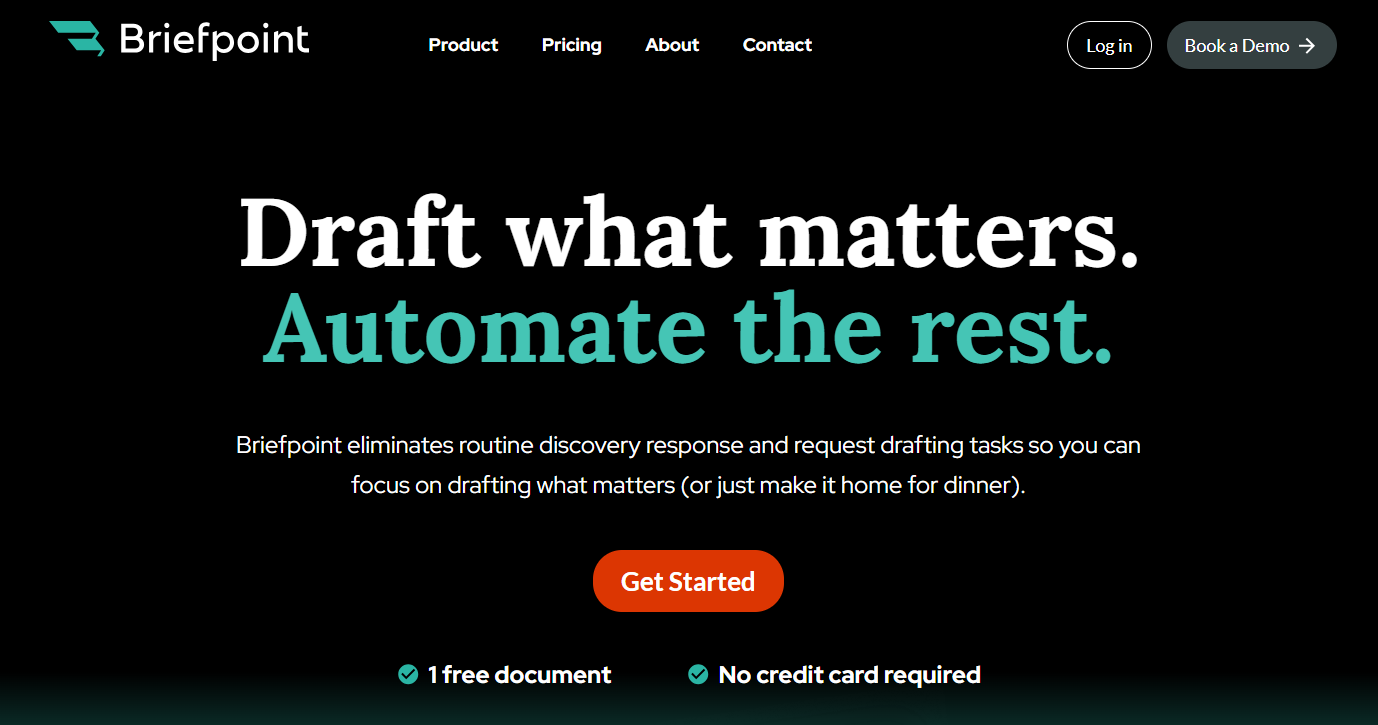
Briefpoint fits right into that effort. Thanks to its powerful AI, it handles routine discovery drafting, requests, and responses without the back-and-forth that slows firms down. Instead of spending hours on the same language for every matter, you upload, review, and download in minutes.
That means:
- Less administrative work
- More consistency across your firm
- And more time for the cases that need your attention
If you’re looking to improve profitability without adding pressure to your team, Briefpoint makes that possible.
Book a demo to see how much time your firm could be saving!
FAQs About Law Firm Profit Margin
Is a 50% profit margin too much?
Not necessarily. While it’s higher than what most firms report, a 50% margin can make sense for solo lawyers or lean firms with low overhead. It usually means you’re either charging a higher rate or operating with fewer expenses. Just make sure it’s sustainable and not coming at the expense of quality, staff burnout, or client satisfaction.
How profitable are small law firms?
It depends on how well they manage their resources. According to industry benchmarks, many small firms aim for a profit margin between 25% and 35%. Firms with a tight handle on their income statement, smart use of automation, and efficient staffing can push a bit higher. Those with high turnover rates or poor systems often struggle to stay consistent.
What is the profit margin for a solo law firm?
Solo attorneys often keep more of their gross revenue simply because they don’t have to split it across a team. Still, they carry all the responsibilities. A solid solo practice can see margins around 40%, especially with minimal office space and low admin costs. Bringing in just one staff member or using tech with real benefits can be a game-changer.
The information provided on this website does not, and is not intended to, constitute legal advice; instead, all information, content, and materials available on this site are for general informational purposes only. Information on this website may not constitute the most up-to-date legal or other information.
This website contains links to other third-party websites. Such links are only for the convenience of the reader, user or browser. Readers of this website should contact their attorney to obtain advice with respect to any particular legal matter. No reader, user, or browser of this site should act or refrain from acting on the basis of information on this site without first seeking legal advice from counsel in the relevant jurisdiction. Only your individual attorney can provide assurances that the information contained herein – and your interpretation of it – is applicable or appropriate to your particular situation. Use of, and access to, this website or any of the links or resources contained within the site do not create an attorney-client relationship between the reader, user, or browser and website authors, contributors, contributing law firms, or committee members and their respective employers.
Make RFP Automation Work for Your Business
Make RFP Automation Work for Your Business
An RFP, or request for proposal, is a formal document companies use when they’re searching for vendors or partners. It outlines what they need, and it’s up to you to respond with a clear, detailed plan showing how you’ll meet those needs.
Sounds simple, right? But anyone who’s actually gone through the process knows it’s anything but. Manually responding to RFPs can be a time sink.
You end up digging through folders, copying answers from old files, double-checking facts, and chasing down teammates for input. And that’s before you even start formatting the final proposal.
If that sounds familiar, you’re not doing anything wrong; it’s just the way most teams handle it. That’s exactly why more businesses are turning to RFP automation and why you might want to, too.

What is RFP Automation?
RFP automation is the use of software to speed up and simplify the RFP response process. Instead of building each proposal from scratch, automation tools help you reuse your best content, assign tasks to the right people, and manage everything in one organized system.
At its core, RFP automation improves RFP response management by making it easier to find accurate answers, assign work to subject matter experts, and deliver polished proposals on time. These tools can also handle security questionnaires, which are often time-consuming and repetitive.
Many platforms now use natural language processing to suggest the best content based on how a question is worded. That means you’re not just pulling canned replies but also getting tailored responses that sound like they were written for that specific request.
With RFP automation, you can:
- Speed up the response process with smart content suggestions
- Cut down manual work by generating answers from a shared library
- Assign sections to subject matter experts with built-in workflows
- Improve consistency with approved, accurate answers
- Handle security questionnaires without last-minute stress
What Is RFP Automation Software?
RFP automation software is a tool that helps teams respond to proposals faster by organizing content, assigning tasks, and reusing approved answers. It’s built to reduce the manual effort that usually goes into answering the same types of questions over and over.
The software keeps everything in one place, including your responses, team comments, deadlines, and drafts, so you’re not jumping between emails or files to piece things together. It also makes it easier to keep answers accurate and consistent across different proposals.
Some tools even suggest content based on past responses to help you save time when you’re under pressure. With everyone working from the same system, the process runs smoother, and your proposals go out quicker.
How Do You Automate RFP Responses?
Automating the RFP response process doesn’t mean handing everything over to a machine. It means cutting down on repetitive work, so your team can focus on writing strong, thoughtful answers.
With the right system in place, you can respond faster and reduce the stress that usually comes with tight deadlines. Here’s how you can set up a smart and efficient RFP response management process using automation tools:
1. Build a Central Content Library
The first step in automating your RFP response process is setting up a robust content library. This is where you store your previous responses, company facts, product details, and other valuable resources in one organized place.
A good library makes it easy to find the right content quickly, which can help your team deliver accurate responses without wasting time. Some tools use machine learning to suggest the best answer based on the question’s context.
2. Use Natural Language Matching
Modern RFP tools use natural language processing to understand how questions are asked, even if the wording changes. This helps the software suggest the most relevant answers from your library, so you’re always starting from a strong place.
3. Assign the Right People Automatically
One of the smartest things RFP software can do is route each question to the right subject matter expert without you lifting a finger.
Legal questions go straight to legal. Product questions land with your technical team. Everyone gets notified, knows what to work on, and sees their deadlines upfront.
This keeps the entire process moving smoothly and avoids confusion or delays. You don’t have to waste time repeating the same steps or chasing people for input. It also keeps your sales process in sync with your proposal efforts, so nothing falls through.
4. Generate Draft Responses
Let your RFP software take the first pass at answering questions. By pulling from your content library, the tool can generate draft responses that save time and reduce repetitive tasks for your team.
You’re still in control (every answer can be reviewed, edited, and approved), but you’re no longer stuck starting from zero.
This approach helps your sales team focus on strategy and personalization, not copy-paste work. Plus, it makes sure answers stay consistent without pulling random info from external websites or outdated files.
Here’s how it helps:
- Creates quick drafts for common RFP questions
- Cuts down the time spent on repetitive writing
- Allows room for human intervention when needed
- Keeps messaging aligned with your brand and voice
- Helps your team stay focused on winning business rather than formatting responses
5. Manage Versions and Approvals
Keeping track of edits and approvals can be a mess when everything’s split across emails and shared drives. RFP automation tools fix that by giving your team one place to manage it all.
This means you can track changes, leave comments, and see who approved what, without dealing with five different versions of the same file.
For example, if you’re answering a set of due diligence questionnaires with input from legal, finance, and IT, the software pulls content from your central library and lets each expert review their section. That way, your winning responses include detailed information pulled from multiple sources, and it’s all up to date.
6. Automate Security Questionnaire Responses
Security questionnaires are often packed with detailed questions that tend to repeat across clients and industries. Automation tools help by pulling approved answers from your knowledge sources and previous RFPs, so your team isn’t stuck rewriting the same content.
Answers stay consistent, accurate, and up to date, even when requests come from different teams or departments. You’ll also get real-time notifications when something needs a second look or an updated response.
By cutting down the busywork, you’re speeding up the process and showing that your team is sharp, responsive, and ready to work with serious clients. That kind of professionalism can go a long way in boosting win rates and helping you stand out as an industry leader.
7. Export Final Proposals Fast
After all the reviews are done and the content’s locked in, the last thing you want is to spend hours reformatting everything. With RFP automation, you can export the entire proposal via Word, PDF, or even a custom layout.
If the client asked similar or the same questions as in past RFPs, there’s no need to do extra research or shuffle through Google Drive for old files. Everything’s already been pulled from approved content.
This is a must-have feature for teams that send out a significant number of proposals and want to ensure consistency across every submission.
Why Should You Automate Your RFP Process?
Manual RFP responses can drag down your team’s time, focus, and energy. When you’re answering the same questions again and again or trying to keep up with disorganized reviews, it’s easy to lose momentum.
Automating the process helps you work faster, stay consistent, and respond with confidence. Here’s what you get out of it:
- Faster turnaround – Generate responses in minutes by pulling from a shared content library, so your team spends less time starting from scratch.
- Consistent, approved content – Use responses that have already been vetted by legal, finance, and subject matter experts.
- Fewer errors – Reduce copy-paste slip-ups and outdated answers with automatic suggestions based on current content.
- Stronger teamwork – Assign sections, set deadlines, and track progress without relying on endless email threads.
- Simpler reviews – Let reviewers edit and approve content in one place, with full visibility into changes and comments.
- Organized process – Keep everything in one system, not spread across docs and drives.
- Better results – Submit polished, accurate proposals that improve your chances of winning the deal.
Take Advantage Of Automated Document Generation Today
You’ve probably spent more hours than you’d like pulling answers together, cleaning up formatting, and chasing final approvals, only to end up sending the proposal minutes before the deadline. It’s frustrating, and honestly, it pulls your focus away from the work that actually needs your attention.
As you can see, automated document generation helps fix that. You can organize your content, reuse what already works, and produce clean documents without jumping through hoops every single time.
And even if RFPs aren’t your main task, you’re likely still dealing with repetitive forms, client documents, or standard questionnaires.

Briefpoint was built to handle that kind of work. Originally made for legal teams, it simplifies structured document drafting, especially when the content is repetitive and requires input from different people. You don’t need to reinvent anything. Just make your process less painful.
If you’re tired of spinning your wheels on the same kinds of documents, Briefpoint is worth a look.
FAQs About RFP Automation
What is RFP automation?
RFP automation refers to the use of software that helps your team respond to proposals faster and with fewer errors. It pulls from your knowledge base, suggests past answers, assigns tasks, and keeps everything organized in one system. The goal is to make the entire process less time-consuming so your team can take on more RFPs without burning out.
What is RFP technology?
RFP technology includes tools and platforms that support the creation, management, and submission of proposals. Some tools even use generative AI to recommend answers based on your previous responses and current questions, helping your team respond quickly while staying accurate.
What is the best RFP software?
The best RFP response software depends on your team size, industry, and workflow. Tools like Loopio, RFPIO, and Responsive are popular for helping teams manage content, track progress, and easily collaborate across departments. Look for features that match your team’s needs and help with things like version control, deadlines, and approval tracking.
What does RFP mean?
RFP stands for Request for Proposal. It’s a document that organizations send out when they’re looking to buy services or multiple products and want vendors to submit bids that meet specific requirements. Responding clearly and with the right data can help your organization stand out and win the deal.
The information provided on this website does not, and is not intended to, constitute legal advice; instead, all information, content, and materials available on this site are for general informational purposes only. Information on this website may not constitute the most up-to-date legal or other information.
This website contains links to other third-party websites. Such links are only for the convenience of the reader, user or browser. Readers of this website should contact their attorney to obtain advice with respect to any particular legal matter. No reader, user, or browser of this site should act or refrain from acting on the basis of information on this site without first seeking legal advice from counsel in the relevant jurisdiction. Only your individual attorney can provide assurances that the information contained herein – and your interpretation of it – is applicable or appropriate to your particular situation. Use of, and access to, this website or any of the links or resources contained within the site do not create an attorney-client relationship between the reader, user, or browser and website authors, contributors, contributing law firms, or committee members and their respective employers.
Document Automation For Lawyers (2025 Step-By-Step Guide)
Document Automation For Lawyers (2025 Step-By-Step Guide)
Legal work is full of documents. And not just a few here and there. We’re talking mountains of forms, responses, and filings that eat up time and energy you’d rather spend on strategy, client meetings, or just getting through your inbox.
That’s exactly why document automation is becoming such a hot topic in legal circles.
If you’re a litigation attorney or run a law firm, you’ve probably started thinking about how AI might fit into your day-to-day workflow.
And the discovery process? That’s one of the best places to start. Automating discovery responses can make a massive difference; not just in how fast you work, but in how confident you feel handing off repetitive tasks to tech that gets it done right.
This guide breaks down exactly what automated discovery response means, why it matters in 2025, and how it can save you time, money, and headaches.
What Is Document Automation?
Document automation allows legal professionals to generate documents using structured templates and case-specific data.
Rather than rewriting similar language for each matter or adjusting old files to fit new scenarios, automation software produces clean, consistent drafts based on your inputs.
This approach is especially useful for high-volume tasks like discovery responses, client communications, and standard agreements. By automating repetitive work, you can reduce drafting time, maintain formatting and language consistency, and minimize the risk of manual errors.
On that note, legal document automation software supports efficiency without compromising control. It gives you the ability to work faster and more precisely. This makes it easier to manage growing caseloads while maintaining a high standard of quality across every document you produce.
What Is Automated Discovery Response?
During litigation, both sides exchange information through formal requests as part of the discovery process. Your reply (known as a discovery response) must address each item requested, typically in one of three ways:
- Comply – Accept the request and provide the requested information.
- Object – Challenge the request if it’s irrelevant, overly broad, or otherwise improper.
- Ignore – Take no action until a court compels a response.
Traditionally, this process required attorneys to review, draft, and format each response manually. Today, automated discovery response tools reduce that workload significantly.
With Briefpoint, you can upload a PDF from opposing counsel, review and categorize each request, and generate a clean, editable Word document in minutes. The platform simplifies the entire response process, without compromising accuracy or legal standards.
Briefpoint Bridge takes it a step further by integrating directly with your CMS. Your finalized documents can be routed instantly, eliminating the need to re-upload or reformat files.
Legal document automation helps you meet deadlines, reduce errors, and spend more time focusing on legal strategy. This is where your attention matters most.
The Benefits of Legal Document Automation for Lawyers
Understanding what legal document automation can do is one thing, but seeing the impact is another. Here are some of the best advantages you can expect when you start investing in legal document automation software:
AI-Supported Discover Responses Save Time
If you’re still drafting responses manually or copying language from old files, you’re likely losing valuable hours.
Legal document automation software changes that. It reads incoming discovery requests, organizes them, and helps you generate accurate responses in minutes, not hours.
By automating legal document creation, you’re cutting down on admin time and freeing yourself up to focus on what actually moves the case forward. Whether you’re a solo attorney or managing a growing team, the right software for law firms helps you get more done without sacrificing quality.
And it’s not just about speed. With automated legal documents, you can take on more cases, hit deadlines with confidence, and eliminate the drag of repetitive drafting.
AI-Driven Discovery Responses Save Money
Saving time means saving money, and with document automation tools, those savings add up quickly. Instead of billing hours for repetitive drafting, you can use legal document generation software to complete discovery responses in a fraction of the time.
Take this example: using a platform that costs $89 per month, attorneys have reported saving around $91 per discovery set. That’s per set, not per month.
And there’s no need for expensive onboarding, extra licenses, or long training sessions. Most tools are built for ease of use, even for attorneys with limited tech experience.
Because these systems often support unlimited uploads and document creation, the cost per use keeps dropping as your caseload grows. Whether you’re handling 10 discovery sets or 50, legal document automation ensures the process stays efficient and affordable.
It Reduces The Reliance On Outside Counsel
Traditional discovery workflows often lead firms to outsource routine drafting to external counsel. This is especially true when time is tight or internal bandwidth is limited. But with the right document automation software in place, that reliance can be significantly reduced.
Legal practice management software combined with document automation tools allows you to bring more of the process in-house.
You can manage discovery requests, oversee the document creation process, and meet response deadlines, all without waiting on third-party availability. That alone helps prevent delays, especially when you’re up against the typical 30-day response window.
More importantly, handling discovery internally gives you greater control over the content and pace of your work. It keeps your team directly involved in the details of each matter, which can be critical for accuracy and case strategy.
That said, automation doesn’t replace legal judgment. Human oversight remains essential. The right document automation software helps generate drafts quickly, but reviewing, editing, and making the final call on objections or disclosures should always stay in your hands.
Document Automation Helps Minimize Human Error
Manual document drafting, whether handled in-house or through outside counsel, often introduces small but costly mistakes. A missed request or a formatting inconsistency can all have serious implications, especially when dealing with complex legal documents.
As mentioned, legal document automation software doesn’t eliminate human oversight, but it does significantly reduce the chances of these routine errors.
With built-in checks and structured templates, document assembly software makes it easier to produce accurate, professional drafts in just a few clicks. Here’s how automation supports error reduction:
- Clear structure – Discovery requests are broken down and organized automatically, so nothing gets missed.
- Standardized formatting – Layouts stay consistent across all documents, even across different cases.
- Spell check and grammar support – Documents are polished and professional by default.
- Fewer copy-paste mistakes – Automated responses are generated from templates, not pieced together manually.
While it’s still important to review each response, using legal document automation tools for document drafting gives you a more reliable foundation. It also helps make sure that every response is complete, clear, and compliant.
Every Document Is Standardized
When you’re preparing discovery responses, consistency is a major expectation.
Luckily, using legal document management software allows you to build templates that carry your firm’s formatting, language, and structure across every response. Your logo, your digital signature, and your layout are applied automatically without extra steps.
Instead of reworking documents every time, you create a repeatable process. With conditional logic and structured templates, the system pulls in client data and adjusts language based on each request. That means fewer formatting changes and documents that hold up under scrutiny.
And if you ever need to review a response later—internally or with a client—it’s all there: what was requested, what was answered, and how it was handled. Document management systems help you keep everything organized, consistent, and easy to track.
It Simplifies Repetitive Legal Work Across Case Types
The legal document creation process often involves reworking the same language across matters, such as intake forms, engagement letters, NDAs, motions, and more.
With law firm document automation in place, your team can generate multiple documents using predefined templates and case-specific data, all within a consistent, repeatable workflow.
This isn’t limited to litigation. Legal teams working in transactional law, compliance, or employment matters can automate the creation of documents they use every day.
Instead of drafting from scratch or modifying older files, automation pulls in the right client information and applies conditional logic to produce accurate drafts in minutes.
For growing firms or busy practices, automating repetitive work allows staff to shift their focus to analysis and strategy while maintaining consistency across every document.
How to Start Automating Your Legal Documents
Getting started with legal document automation doesn’t require a full overhaul of your operations. In most cases, it begins with identifying the documents you create most often and building structured templates around them.
Here’s a practical way to begin:
1. List High-Volume Documents
The best place to begin with secure legal document automation is by identifying which documents your firm creates most frequently. These are often repetitive, time-consuming to draft manually, and ideal candidates for automation.
By targeting high-volume tasks first, you get the fastest return on investment and can quickly reduce the administrative burden on your legal team. You’ll also create a strong foundation to build on as you automate more complex workflows over time.
Common starting points include:
- Engagement letters – Often similar across clients and easy to automate with client-specific data
- Discovery responses – High volume in litigation and well-suited for conditional logic
- Fee agreements – Usually standard in structure, with only minor case-specific edits
- Client intake forms – Can be transformed into structured data for automated document generation
- Standard motions or pleadings – Frequently reused formats that benefit from consistency
Using automation software for law, you can create legal documents quickly and accurately, with the added benefit of centralized storage and version control.
Many platforms offer secure legal document automation features, which help make sure that client information remains protected while your team works more efficiently. This simple first step can lead to significant time and cost savings across your entire practice.
2. Choose the Right Software
Not all automation tools are built with legal workflows in mind. To get the most value, look for leading document automation software designed specifically for law firms; tools that support conditional logic, template management, and integration with your case management system.
These features allow you to automate the creation of court documents, client communications, and other routine paperwork without disrupting your current processes.
A strong platform should handle complex legal drafting while keeping the user experience straightforward. The best options make it easy to standardize language, reduce manual input, and maintain version control, whether you’re handling a solo practice caseload or operating as part of an enterprise law firm.
Briefpoint is one example of a premier document automation solution built specifically for the legal industry. Designed to help law firms integrate seamlessly with their existing systems, it supports efficient automation of discovery responses and other litigation tasks, while giving attorneys full control over review and edits.
3. Create Structured Templates
Once you’ve selected the best document automation software for your practice, the next step is building structured document templates.
These templates form the backbone of automation and allow you to generate consistent legal documents by plugging in case-specific details like client names, dates, and matter numbers.
By using variables and conditional logic, you avoid repetitive edits and eliminate the risk of errors tied to duplicate data entry. Law firms boost efficiency by building a strong library of document templates across departments (while maintaining high standards for legal services).
A well-structured template typically includes:
- Placeholder fields for names, dates, and case numbers
- Sections that adapt based on case type or client input
- Pre-approved language that aligns with firm-wide standards
For law firms with comprehensive workflows, these templates help scale operations without sacrificing accuracy. Whether you’re creating standard correspondence or court filings, structured templates are essential for turning automation into a sustainable part of your legal practice.
4. Connect to Your Data
If you’re still copying information from one system to another, you’re frankly wasting time and increasing the risk of mistakes. But with the right automation setup, you don’t have to.
Pulling information directly from client intake forms, case files, or matter data allows you to automatically fill in your document templates without manual data entry.
This step is key to making automation truly useful in day-to-day work. When law firms seamlessly integrate their document automation tools with existing systems, everything flows more efficiently.
For law firms comprehensive in their operations, connecting data sources directly into the document management process makes sure every file is consistent and audit-ready. It also means your team can move faster without cutting corners, freeing up time for higher-value legal work.
5. Test and Refine
Once your templates are in place, don’t rush to automate everything at once. Start with a few repetitive legal documents—those you draft most often—and test how well they perform within your new document automation platform.
Review each automated draft carefully to make sure the output aligns with your standards, tone, and formatting.
For example, you might begin by automating client engagement letters or discovery requests. These are typically straightforward, high-volume documents that benefit immediately from structured document workflows.
As you gain confidence, you can expand to other use cases, including motion templates, internal memos, or even legacy documents that have been manually handled for years.
This phased approach gives you room to fine-tune each part of the workflow automation process. It also helps your team adapt gradually without disrupting existing operations.
Over time, you’ll build a stronger, more scalable automation system that fits your firm’s exact needs but without sacrificing quality or control.
Automate Smarter, Focus on What Matters
Manual drafting slows everything down, from your workflow to your ability to serve clients at the highest level.
Document automation can change that permanently. Eliminating repetitive tasks and connecting seamlessly with other legal tech systems gives your team the space to think, analyze, and deliver more value where it counts.
For firms committed to providing exceptional legal counsel, automation isn’t just a nice upgrade; it’s becoming a necessary one. When documents are created faster and with fewer errors, you gain more control, improve consistency, and operate with less friction across every case.
Briefpoint helps make that transition smooth. Its platform is built for law firms that want precision without complexity. Discovery responses are just the beginning.
Book your Briefpoint demo now and see how effortless document automation can become part of your everyday practice.
FAQs About Document Automation For Lawyers
What is document automation in law?
Document automation in law refers to the use of software to generate legal documents based on structured templates and client data. It streamlines document assembly processes, allowing law firms to create consistent, accurate documents with far less manual input.
Can lawyers be automated?
While certain repetitive tasks like drafting standard documents or managing intake forms can be automated, legal judgment, negotiation, and strategic decision-making cannot. Document automation is suitable for supporting lawyers, not replacing them, so they can focus more on resolving legal issues and less on routine paperwork.
What is an example of document automation?
A common example is automating discovery responses. Instead of drafting each one manually, lawyers can use document automation tools to generate responses using client data and pre-approved language, significantly reducing time and eliminating duplicate data entry.
Do lawyers use DocuSign?
Yes. Many law firms use DocuSign and other legal tech tools for electronic signatures and workflow automation. While DocuSign isn’t a document automation platform by itself, it often integrates with systems that handle drafting and approvals.
The information provided on this website does not, and is not intended to, constitute legal advice; instead, all information, content, and materials available on this site are for general informational purposes only. Information on this website may not constitute the most up-to-date legal or other information.
This website contains links to other third-party websites. Such links are only for the convenience of the reader, user or browser. Readers of this website should contact their attorney to obtain advice with respect to any particular legal matter. No reader, user, or browser of this site should act or refrain from acting on the basis of information on this site without first seeking legal advice from counsel in the relevant jurisdiction. Only your individual attorney can provide assurances that the information contained herein – and your interpretation of it – is applicable or appropriate to your particular situation. Use of, and access to, this website or any of the links or resources contained within the site do not create an attorney-client relationship between the reader, user, or browser and website authors, contributors, contributing law firms, or committee members and their respective employers.
Why You Need Legal Process Automation in 2025
Why You Need Legal Process Automation in 2025
Unless you’re the most efficient law firm to ever exist, chances are, you need legal workflow automation. Even the most well-oiled legal teams deal with time-consuming processes, repetitive admin tasks, and outdated systems that slow everything down.
But what is automation in the first place? And why is law one of the most suitable industries for it? Legal work relies heavily on documentation, rules, deadlines, and structured procedures. This fact alone makes it a perfect match for smart automation tools.
Let’s talk about legal process automation (LPA), how it works, and why you need to automate legal processes before your competitors take the lead.

Legal Process Automation is More Than Just Automating Tasks
When people hear “legal process automation,” they often think it’s just about automating repetitive tasks. While that’s a big part of it, LPA goes much deeper. It’s about using technology to create a more efficient, integrated system that improves every aspect of your legal practice.
Think of it like this: legal process automation isn’t just a tool for reducing paperwork or speeding up routine tasks. It revolves around transforming how your entire firm operates.
With LPA, you can simplify document management, improve client communication, and make sure that every part of your workflow is running as smoothly as possible.
A Quick Example: Client Onboarding
Traditionally, onboarding a new client is a manual, time-consuming process. Clients schedule consultations and share details during meetings, and then staff manually enter this information into the system.
Standard legal documents are drafted, sent out for signatures, and followed up with multiple reminders. Finally, signed documents are manually filed.
This method is not only slow but also prone to errors.
Now, imagine an automated process. Prospective clients book consultations online. They receive automated emails with secure links to online forms, which gather all necessary details and documents. This data is then automatically entered into the firm’s system.
Legal document automation software generates standard engagement letters and retainer agreements, which are sent out for electronic signatures. Automated reminders help with timely completion, and signed documents are automatically stored in the firm’s digital filing system.
The result? Less time and effort spent on such a simple task.
What Legal Workflows Can You Automate?
Legal automation tools can help you automate legal workflow processes across your entire firm, improving both speed and accuracy. Whether you’re handling routine admin or complex legal operations, here are the top areas where automation makes the biggest impact:
- Creating and managing documents – Use templates and automation to draft, store, and organize documents quickly with fewer errors.
- Client onboarding and data entry – Online forms collect client info and automatically sync it with your system, making intake smoother.
- Billing and invoicing – Automate time tracking, invoice generation, and payment reminders to maximize profitability.
- Contract review – AI-powered legal automation tools highlight key clauses and spot issues, cutting down manual review time.
- Legal research – Let automation handle case law and precedent searches, so you can focus on strategy.
- Task and deadline management – Set up alerts to stay on top of everything and avoid missed deadlines.
- Client communication – Send updates, appointment reminders, and follow-ups automatically.
- Case management – Centralize all aspects of your legal operations, from tracking progress to coordinating stakeholders.
- Compliance and risk – Automate updates and reporting to keep your practice in line with evolving regulations.
Benefits of Automating Legal Processes
Automating legal processes doesn’t just keep you on top of tech trends; it brings real, game-changing benefits to your practice.
Let’s take a look at a rundown of how it can make a big difference for law firms and in-house legal teams:
1. Increased Efficiency
Automation slashes the time spent on the grind of administrative tasks, which, in turn, lets your legal team focus on the stuff that needs human judgment and expertise.
For instance, why spend hours on manual document drafting when document automation software can handle it in minutes?
Take Briefpoint, for example. It’s a generative AI and machine learning tool that drafts discovery responses and request documents for you.
Traditionally, this process can take hours as you would need to pore over the information and create an appropriate response.
With Briefpoint, the AI will extract information from the document for you and create a mostly finished document. The human touch comes when you add objections or responses to the document to complete it.
Take a look at how it works today.
In short, this is one of the easiest ways for legal teams to save time on document creation using advanced document automation tools designed for the legal field.
2. Cost Savings
Streamlining your processes through automation means you’re also cutting down on costs. Less time spent on routine tasks translates to lower labor costs and fewer hours billed.
Plus, reducing human error means spending less on fixing those errors, which can really add up.
Such a level of efficiency lets you redirect funds to areas that can help grow your legal services, like tech upgrades or marketing.
3. Improved Accuracy
Let’s face it, everyone makes mistakes, but automation keeps them to a minimum. Automated systems stick to the rules you set, which drastically cuts down the chances of slips and blunders.
Naturally, this is a big deal in law, where even a tiny error can lead to huge legal issues. For example, automating contract reviews helps make sure every document meets compliance standards without a hitch.
Will automation replace lawyers? No, but it does significantly reduce the risk of human error by accurately processing legal data and flagging issues early.
4. Better Client Service
Faster processes and smoother operations mean you can offer your clients a better experience. Quick turnarounds and efficient handling of their cases can make your firm stand out in a crowded market.
In the legal industry, automation solutions help streamline processes so your team can spend more time on strategic tasks that truly impact client satisfaction.
5. Increased Compliance
Keeping up with regulations is no small task, especially when they’re always changing. Automation tools can be programmed to follow the latest laws to the letter, updating automatically as new regulations roll out.
This not only helps you avoid penalties but also protects your firm’s reputation by making sure you’re always on the right side of the law.
Legal Technology Isn’t Perfect, But Neither Are Humans
There’s a lot of talk about automation in the legal world right now, and for good reason. Still, many law firms are cautious about adopting new technology. The biggest hesitation? Legal tech isn’t perfect.
That concern is valid, but human work isn’t flawless either. Errors happen, especially under pressure or when dealing with repetitive tasks. Rather than expecting technology to solve everything, it’s more productive to see it as a support system that helps reduce risk and improve consistency.
Here’s a closer look at why some firms hesitate and why that hesitation could be holding them back.
The Accuracy Anxiety
Lawyers pride themselves on precision and thoroughness. So, it’s no surprise that there’s a fear of automated systems missing critical nuances or making costly errors.
Yes, AI can sometimes misinterpret data or struggle with ambiguous legal language. But humans are just as prone to mistakes, especially when overwhelmed or short on time.
Automation helps reduce these errors by providing consistent, rule-based analysis and removing the fatigue factor from routine legal tasks.
For example, in contract management, an automated workflow can scan large volumes of agreements to flag missing clauses or inconsistencies.
That means lawyers don’t have to spend valuable time sifting through every line manually and can instead focus on reviewing the most relevant data.
By combining automation with human review, legal teams can maintain quality while working faster and more efficiently.
Cost and Implementation Hurdles
Implementing new technology isn’t cheap, and the learning curve can disrupt daily operations. Smaller firms, in particular, might find the upfront costs daunting. However, the long-term gains often outweigh these initial expenses.
Automation helps reduce time-consuming tasks that eat into productivity and rack up non-billable hours.
By minimizing manual work, like sorting through unstructured data or tracking down missing case details, firms free up their staff to focus on higher-value tasks that directly support client outcomes.
Increased efficiency, fewer errors, and better resource management can lead to substantial savings over time. Plus, many tech solutions are scalable, which makes them accessible to firms of all sizes.
The Tradition Trap
Lawyers are traditionally cautious, which makes sense given the high stakes of their work. This cautious nature often translates into resistance to change, especially when it involves new and unfamiliar technology.
However, clinging to outdated methods and manual processes can be more harmful in the long run. As clients demand faster and more efficient service, firms that resist automation risk falling behind their more tech-savvy competitors.
Modern tools can support self-service options for clients, automate non-billable tasks, and even generate contracts quickly for routine business deals. These improvements don’t replace legal judgment; they free up time so lawyers can focus on higher-value strategy and client relationships.
Embracing Imperfection
Ultimately, the truth is that neither legal technology nor humans are perfect. Both have their strengths and weaknesses. The key is to find a balance that leverages the best of both worlds.
Automation can handle repetitive, data-heavy tasks with precision, while human lawyers can focus on the strategic work that machines can’t replicate. By acknowledging the imperfections on both sides, legal teams can create a more efficient, effective, and client-centered practice.
The Legal Automation Software You Need: Briefpoint
What’s the biggest bottleneck in discovery? Most legal professionals will tell you it’s the paperwork or, more specifically, the standard legal documents like discovery responses and requests.

If you want to lift this burden off your legal department, it’s time to invest in artificial intelligence. Briefpoint is a generative AI tool that creates discovery documents for you so you don’t have to spend hours manually drafting each one.
Here’s a glimpse of what documents Briefpoint can handle:
- Requests for Production
- Requests for Admission
- Interrogatories
Ready to reduce busywork and refocus your team on what really matters? Book a demo with Briefpoint and see how much time and effort you could save.
FAQs About Legal Automation
What is legal workflow automation?
Legal workflow automation refers to the use of technology to simplify and structure repetitive processes within a law firm. It helps reduce manual work, improves accuracy, and allows legal experts to focus on more strategic responsibilities instead of getting bogged down with low-value tasks.
What is an example of process automation?
A good example is client intake automation. Instead of manually collecting client information through phone calls or emails, firms can use secure online forms that automatically capture and organize data in their system. This saves time and creates a smoother onboarding experience.
What is automation in law?
Automation in law involves using software to handle routine legal processes like document drafting, contract review, and billing. It allows firms to implement self-serve options, such as letting clients book appointments or complete forms online without assistance.
What is the best document automation software for lawyers?
The best document automation software depends on your firm’s needs, but Briefpoint is a strong choice for discovery documents. Tools like this help lawyers generate contracts and other paperwork quickly, giving them a competitive edge by freeing up time for more complex work.
The information provided on this website does not, and is not intended to, constitute legal advice; instead, all information, content, and materials available on this site are for general informational purposes only. Information on this website may not constitute the most up-to-date legal or other information.
This website contains links to other third-party websites. Such links are only for the convenience of the reader, user or browser. Readers of this website should contact their attorney to obtain advice with respect to any particular legal matter. No reader, user, or browser of this site should act or refrain from acting on the basis of information on this site without first seeking legal advice from counsel in the relevant jurisdiction. Only your individual attorney can provide assurances that the information contained herein – and your interpretation of it – is applicable or appropriate to your particular situation. Use of, and access to, this website or any of the links or resources contained within the site do not create an attorney-client relationship between the reader, user, or browser and website authors, contributors, contributing law firms, or committee members and their respective employers.
Smart Ways to Reduce Law Firm Operating Expenses in 2025
Smart Ways to Reduce Law Firm Operating Expenses in 2025
Running a law firm takes money, and lots of it. Between rent, staff, software, and basic supplies, expenses can pile up fast. Some are obvious. Others slip under the radar until they start cutting into profits.
Understanding your law firm’s operating expenses is key to staying profitable and competitive. When you know where your money goes, it’s easier to cut waste and plan for growth.
Whether you’re running a solo practice or managing a mid-sized team, keeping expenses under control helps you stay focused on your high-value legal work.
In this guide, we’ll break down what counts as an operating expense, how they differ from other costs, what law firms typically spend money on, and how to lower your overhead without hurting performance.

Best Strategies To Lower Your Overhead Expenses
Reducing overhead can help your firm stay lean and focused without hurting performance. Here are some straightforward ways to bring down costs and keep operations efficient.
1. Review Your Budget and Expenses
One of the easiest ways to reduce overhead costs is to take a closer look at your current spending. Many law firms don’t realize how much they’re spending on things they no longer use or need.
Regular expense management helps you spot waste and adjust before it becomes a problem. Start with a full review of the past three to six months.
Look for:
- Unused software subscriptions
- Office supplies that get overordered
- Services with cheaper alternatives
- Charges that show up month after month without review
Set clear spending limits for each department or category so nothing gets out of hand. Even small cuts across a few areas can lead to significant savings over time. With a tighter grip on your budget, you’ll find more cost-saving opportunities and avoid surprise expenses that eat away at profits.
2. Take Advantage of Automation Tools
Automation can help your legal practice reduce labor costs, save time, and avoid hiring more staff than you need. For the average firm, these tools are a simple way to reduce costs related to manual work and improve productivity across the board.
Here are a few types of automation tools to consider:
- Time tracking and billing tools – Log hours and create invoices automatically.
- Client intake software – Collect client info through smart forms.
- Appointment schedulers – Cut down on back-and-forth emails.
- Document automation – Quickly create legal documents using pre-set templates.
- Task and workflow tools – Manage to-dos and deadlines in one place.
One powerful option is Briefpoint, which lets you generate discovery responses and other legal documents in minutes. It helps firms reduce staffing costs, spend less time on repetitive tasks, and focus more on billable work.
By using automation the right way, you’ll save money while keeping your firm organized and efficient without sacrificing quality.
3. Consider Outsourcing Your Biggest Bottlenecks
If your firm is constantly stretched thin, outsourcing can be a smart way to protect your time and budget. Instead of hiring more full-time staff, which drives up employee salaries and other ongoing costs, consider outsourcing areas that slow you down the most.
Common examples include IT support, marketing, and even billing processes. For instance, outsourcing your billing to a team familiar with legal software can keep your payments on track while freeing up your team for client work. It also means fewer errors and faster invoicing.
This approach allows you to redirect the firm’s resources toward client service and future growth. You’re not cutting corners but simply shifting some of the load to outside experts who can do it faster and cheaper.
It also gives you flexibility as it lets you scale up or down without the long-term commitment of hiring more staff. When used wisely, outsourcing can support your growth while keeping costs predictable.
4. Invest in Legal Accounting and Billing Software
Legal accounting and billing tools play a big role in keeping your firm’s finances on track. Without proper systems, you risk missing billable hours, sending late invoices, or dealing with delayed payments—all of which can hurt your firm’s profitability.
These tools help you manage billing, track expenses, and process electronic payments within the same time period. You’ll know exactly what’s been billed, what’s unpaid, and what’s coming up. That kind of visibility makes it easier to plan ahead and avoid cash flow problems.
In a competitive market, staying organized with billing helps build trust and keeps client relationships strong. Choosing legal-specific software also means better support for compliance and trust accounting rules.
Over time, these systems support long-term success by improving accuracy and reducing the time you spend on manual tasks.
Overview of Operating Expenses For Law Firms
Operating expenses are the everyday costs it takes to run your law firm. These include things like rent, salaries for support staff, office supplies, software subscriptions, and insurance. They’re the ongoing costs that keep your doors open, regardless of how many clients you have or cases you win.
The key thing to remember is that operating expenses aren’t tied directly to client work. They’re about keeping your business running.
To make it clearer, here’s how they differ from other types of law firm expenses:
- Direct (or client-related) expenses – Costs that are billed to a specific case or client, like court filing fees, expert witness fees, or travel for a deposition.
- Capital expenses – Long-term investments like buying office furniture, computers, or upgrading your case management system.
- Non-operating expenses – Costs not related to daily operations, such as interest on loans or one-time legal settlements.
Operating expenses are regular and predictable. Keeping a close eye on them can help you spot savings opportunities and maximize your profits without sacrificing quality or service.
What Kind of Operating Expenses Do Law Firms Have?
Law firms deal with a variety of expenses just to keep things running day to day. While some are fixed, like rent, others change month to month, like office supplies or utilities. Here’s a breakdown of the most common ones you’ll see on a law firm’s books.
Office Rent and Utilities
In the legal industry, office rent is often one of the biggest contributors to law firm overhead expenses. Whether you’re in a downtown high-rise or a small suburban suite, the cost of office space adds up quickly.
But rent isn’t the only bill. There’s also electricity, internet, water, air conditioning, heating costs, and even janitorial services. If your firm relies on a physical space to meet with clients or hold team meetings, these costs are unavoidable.
For many firms, especially those in larger cities, utilities and office rent cost a huge chunk of the monthly budget without much flexibility to cut back.
Staff Salaries and Benefits
Staff salaries and benefits make up a major part of a law firm’s overhead costs. These include wages for paralegals, legal assistants, receptionists, and other support staff who help keep things running smoothly.
Beyond base pay, you’ve also got expenses incurred from health insurance, paid time off, retirement contributions, and other perks. While these roles aren’t billable, they’re essential to daily operations.
If left unmanaged, they can quietly strain your law firm’s budget. Keeping these costs in check is important not just for short-term savings but also for your firm’s financial health in the long run.
Software and Technology Tools
The average law firm relies on a mix of software and tech tools to handle everyday tasks. Think time tracking, billing, case management, and document automation. These tools cut down on manual work and help you stay organized, but they also come with a price tag.
Subscriptions, updates, and user licenses are considered soft costs, meaning they don’t show up on a client’s bill but still count toward your business expenses.
For many firms, especially growing ones, these tools are necessary to stay competitive. Still, it’s smart to review them regularly to make sure you’re not paying for more than you need.
Marketing and Client Outreach
Marketing is a regular part of running a law practice. Legal professionals often invest in websites, Google ads, social media tools, and email campaigns to bring in new clients.
These efforts aren’t just optional; they’re part of staying competitive. While marketing expenses are not always cheap, they’re a necessary part of building your brand and keeping your pipeline full.
Office Supplies and Equipment
It’s easy to ignore how much your team spends on a daily basis until you check the receipts. Office supplies like paper, pens, printer toner, sticky notes, and mailers quietly chip away at your budget.
Add basic equipment like filing cabinets or desk chairs, and it becomes clear these “small” purchases play a bigger role in overall spending than expected.
Spend More Time on Billable Work With Briefpoint
Legal drafting shouldn’t eat up half your day, especially when it’s the same type of work over and over. Briefpoint changes that.
Instead of rebuilding discovery responses from the ground up, you upload your file, make your selections, and get a clean draft in just a few minutes.

It’s built specifically for law firms that want to cut back on low-value tasks without compromising quality. Less manual work means fewer distractions, smaller staffing needs, and more time spent on client matters that actually bring in revenue.
If your firm is trying to do more without constantly adding to the workload, Briefpoint is the tool that helps you get there faster, cleaner, and with less overhead.
FAQs About Law Firm Operating Expenses
What are the overhead costs for law firms?
Overhead costs are the ongoing expenses needed to run a firm, regardless of how many clients you serve. These include rent, utilities, non-lawyer salaries, office supplies, software, and more. They aren’t tied to a specific case but directly affect your overhead rate and overall profitability.
Are legal expenses part of operating expenses?
Not usually. Legal expenses like court filing fees or expert witness costs are often billed directly to clients and aren’t counted as operating expenses. Operating costs relate to running the firm itself—things like payroll, software, and insurance must be properly tracked as business overhead.
What do law firms spend the most money on?
According to industry averages, the biggest expenses are typically office rent, staff salaries, legal software, and insurance. Travel expenses and marketing can also add up quickly, depending on the size and type of practice.
How do overhead costs affect prospective clients?
High overhead can lead to higher fees, which may turn away prospective clients. By finding ways to cut costs, you can stay competitive without sacrificing quality.
Why is keeping track of expenses so important?
Tracking every expense helps identify revenue sources, make informed decisions, get paid faster, and improve profitability by reducing waste and saving valuable time.
The information provided on this website does not, and is not intended to, constitute legal advice; instead, all information, content, and materials available on this site are for general informational purposes only. Information on this website may not constitute the most up-to-date legal or other information.
This website contains links to other third-party websites. Such links are only for the convenience of the reader, user or browser. Readers of this website should contact their attorney to obtain advice with respect to any particular legal matter. No reader, user, or browser of this site should act or refrain from acting on the basis of information on this site without first seeking legal advice from counsel in the relevant jurisdiction. Only your individual attorney can provide assurances that the information contained herein – and your interpretation of it – is applicable or appropriate to your particular situation. Use of, and access to, this website or any of the links or resources contained within the site do not create an attorney-client relationship between the reader, user, or browser and website authors, contributors, contributing law firms, or committee members and their respective employers.
Paralegal Drafting and Document Automation Tools
Paralegal Drafting and Document Automation Tools
Legal work moves fast, and there’s often more to do than hours in the day. Paralegals help keep it all on track. From prepping court filings to organizing case details, they handle the kind of work that keeps everything running behind the scenes.
One of their most important roles? Drafting legal documents.
But what exactly can paralegals draft? Where’s the line between support and legal practice? And how does document automation fit into all of this?
This guide breaks it all down: what paralegals do, what they don’t, and how the right tools can make their work smoother, faster, and more accurate.

What Is A Paralegal And What Do They Do?
A paralegal is a legal professional who works under the supervision of a lawyer to support legal tasks. They’re not licensed to practice law, but they’re trained to handle a variety of responsibilities that help law firms, corporations, and government agencies run smoothly.
From legal research to document prep, paralegals are trusted with a big part of the workload. They must follow strict rules and can’t offer legal advice, but they still play a key role in legal services by taking care of the behind-the-scenes work that keeps cases moving forward.
Common Tasks Paralegals Handle
Paralegals juggle a mix of duties that keep legal teams organized and efficient. Here’s what they typically do:
- Draft legal documents like contracts, discovery responses, and pleadings.
- Research laws and case history to help lawyers build their arguments.
- Organize case files and maintain document management systems.
- Handle client communication under supervision, such as scheduling or updates.
- File paperwork with courts and agencies on time.
- Prepare trial materials like summaries, timelines, and exhibit lists.
- Review documents for accuracy and completeness.
While they can’t represent clients or provide legal advice, paralegals help lawyers focus on strategy by taking care of the groundwork.
Can Paralegals Draft Legal Documents?
Yes, paralegals can draft legal documents, but there are clear boundaries. They’re allowed to prepare documents as long as a licensed attorney supervises and approves the final versions.
This means paralegals can take on much of the initial drafting work, which saves a lot of time. However, they can’t act independently or offer legal advice during the process. Every document they prepare must ultimately be reviewed and signed off by the supervising attorney.
The rules vary slightly depending on the state or country, but the general idea is the same: paralegals can assist with document preparation but can’t replace a lawyer’s judgment or authority.
Drafting contracts, pleadings, affidavits, and other legal materials is part of their regular workflow, especially in busy law firms. Still, it’s important to remember that clients can’t rely solely on paralegals for legal documents without lawyer involvement.
At the end of the day, lawyers are held responsible for the legal accuracy and quality of all documents that come out of their office, even if a paralegal does the bulk of the work behind the scenes.
What Kind Of Documents Can Paralegals Draft?
Paralegals are trained to support lawyers by preparing various legal documents that play a big role in legal proceedings. While they can’t finalize documents without a lawyer’s review, they handle much of the legal document drafting work to help move cases forward efficiently.
They often rely on legal research databases to gather accurate information and ensure the documents are complete and well-informed.
Plus, the drafting process involves using templates, reviewing past cases, and double-checking facts to create legally sound documents.
Here are some of the most common types of legal documents paralegals draft:
- Contracts – Employment agreements, service contracts, non-disclosure agreements.
- Pleadings – Complaints, answers, motions, and other court filings.
- Discovery documents – Interrogatories, requests for production, and responses.
- Affidavits and declarations – Written statements sworn to be true under oath.
- Wills and trusts – Basic estate planning documents prepared under lawyer supervision.
- Settlement agreements – Used to resolve disputes before or during legal proceedings.
- Legal correspondence – Letters to clients, opposing counsel, or court personnel.
- Case summaries and timelines – Used to support trial prep and presentations.
As you can see, paralegals play a key role in the drafting process. Essentially, they help lawyers create various legal documents that are accurate, organized, and legally sound.
What Is The Role of Document Automation?
If you’ve ever had to draft the same type of legal document more than once, you know how repetitive it can get. Document automation helps cut down on all that manual work.
Contrary to what some professionals might think, it’s not some high-tech tool only used by massive firms. It’s actually built for everyday tasks paralegals deal with, like filling in names, dates, and clauses that don’t really change all that much.
So, how did it all start?
Legal teams have always looked for ways to save time and avoid mistakes. At first, it was just copy-pasting from old files. Then came templates. But even that got messy when things had to be updated over and over again.
That’s when document automation took off. Its goal is to help you build a solid draft without the back-and-forth and without missing key details.
Here’s how it works: you answer a few basic questions (or fill out data fields or upload your document for scanning), like the client’s name, key dates, or terms, and the software fills out the document for you. It uses preset templates built by your team and pulls info from your system or even legal research databases.
The bottom line: It’s much like a smart assistant that already knows the format, the language, and what goes where. Legal professionals and paralegals stay in control, but with less busywork.
What Are The Benefits of Legal Document Automation?
Legal document automation has changed how legal teams handle paperwork. What used to take hours can now be done in minutes.
For paralegals, especially, it means spending less time on repetitive tasks and more time on work that actually needs their input. So, how does this shift affect the way you work? Let’s break it down.
Saves Time on Repetitive Tasks
Automation tools take care of the busywork by using pre-built templates and pulling info from forms, legal databases, or past cases.
Instead of typing out the same clauses, headings, and legal terms over and over, you simply enter the case-specific details, and the system handles the rest.
That means you can spend less time on formatting and more time reviewing the final product or conducting legal research when needed. It also makes legal writing faster and less tiring, particularly when working under tight deadlines, ultimately reducing paralegal burnout.
Here’s how it helps:
- Fills in standard legal language automatically
- Pulls client data directly from legal databases
- Reduces time spent rewriting the same documents
- Keeps formatting and structure consistent across drafts
Cuts Down on Errors
Manual document drafting often leads to simple but costly mistakes like typos, wrong dates, missing sections, or inconsistent formatting. These errors might seem small, but in legal disputes, they can cause delays or even hurt a client’s case.
Document automation helps avoid these issues by using templates with standard language and pulling case details directly from trusted systems.
For example, instead of retyping the same discovery response in multiple places, a legal assistant can enter the information once, and the system applies it across the entire document.
Paralegal education programs now include training on these tools, knowing how important they’ve become in everyday legal processes. When used correctly, automation supports the quality of legal writing and reflects the kind of attention to detail expected in the profession.
It allows paralegals and legal assistants to focus more on thorough legal research and case strategy rather than fixing the same errors again and again.
Keeps Work Organized
Staying organized is one of the biggest challenges in a busy legal practice. When you’re handling several matters at once, it’s not hard for things to get scattered. Unfortunately, these small issues can quickly slow things down or lead to mistakes.
Document automation helps avoid that by keeping everything in one place. Templates, drafts, and final versions are easy to find, clearly labeled, and tied to the right case. You can see who last made edits, what’s been changed, and what still needs review.
Here’s how it helps:
- Keeps documents organized and easy to track
- Connects each draft to the right matter automatically
- Reduces back-and-forth between team members
- Makes sure each document reflects the most up-to-date information
Great organization goes a long way. By keeping the drafting process clear and structured, automation helps you stay on top of the details and support more successful legal outcomes.
Improves Consistency Across the Board
The legal landscape demands clear, consistent communication. Whether one person or several are involved in drafting, every document needs to match in tone, structure, and formatting.
Document automation helps maintain consistency by using shared templates that apply the same standards across the board.
For example, if two legal assistants draft similar pleadings without automation, one might include case law references while the other skips them. That inconsistency can be confusing or even hurt the case.
Automation keeps everything aligned, which makes it easier to present polished, professional documents every time.
Document Automation: Best Practices For Paralegals
Using document automation the right way can make your day a lot smoother. When used correctly, automation supports your role and helps you avoid mistakes that can slow things down later.
If you’re a paralegal looking to get the most out of automation tools, there are a few simple habits that can make a big difference.
1. Start With Clean, Approved Templates
One of the most essential skills in legal document drafting is knowing where to start, and that means using the right template. Whether you’re drafting pleadings, contracts, or discovery responses, always begin with a template that’s been reviewed and approved by your legal team.
These templates follow firm-specific formatting, use the correct legal language, and stay in line with procedural rules. Using an outdated or unofficial version can lead to errors that take extra time to fix.
If there’s any doubt, check with a supervising attorney or senior paralegal to make sure you’re working from the most current version.
2. Review Every Output Before It Leaves Your Desk
In the legal field, attention to detail is non-negotiable. Even if automation tools do most of the work, it’s still your responsibility to make sure the document complies with formatting rules, legal standards, and case-specific details.
Always review the output carefully. Check for missing names, incorrect dates, or formatting that doesn’t match the firm’s expectations. These small mistakes can easily slip through if you rely too heavily on the tool.
Remember: solid drafting skills aren’t just about writing; they’re also about knowing when something doesn’t look right.
3. Don’t Skip the Legal Review
No matter how advanced the software is, an automated draft is never the final version. It still needs a lawyer’s approval before it’s ready to go.
Even if the document looks complete, a supervising attorney needs to confirm that it meets legal standards and serves its purpose. Your role is to make sure the draft is clean, accurate, and easy to review.
This mindset reflects the kind of professionalism that law school teaches and supports your long-term professional development. A careful review can make all the difference in a document’s effectiveness.
4. Stay Updated on the Tools You Use
Automation tools are always evolving. New features, improved templates, and system updates roll out regularly. So, staying current with those changes helps you work more efficiently. Taking a few minutes to explore new options or read internal tips can save you time in the long run.
For example, Briefpoint regularly updates its platform and adds smart features designed to make legal drafting even smoother. We also publish helpful blogs and cheat sheets that explain how to get the most out of the tool.
5. Use Notes and Comments When Needed
Not every draft will be perfect on the first try, especially when it involves key aspects of a case that require legal interpretation or specialized knowledge.
If you’re unsure about a clause, a date, or how to phrase something specific to the parties involved, don’t guess. Add a clear comment or note for the reviewing attorney.
This kind of communication shows you’re paying attention and thinking through the details. Experienced paralegals know that leaving helpful notes not only speeds up the review process but also builds trust with attorneys who rely on clean, thoughtful drafts.
Brieftpoint Helps Your Paralegals Be Even More Efficient
Paralegals don’t need more software. They need tools that actually reduce the back-and-forth.
Briefpoint is built for one purpose: helping legal teams draft and respond to discovery documents faster and with fewer errors. It handles Interrogatories, Requests for Admission, and Requests for Production.

Here’s how it works: Upload a PDF of your complaint or opposing counsel’s requests. Briefpoint scans the document, extracts key info like court name and request type, and formats everything based on local rules.
You can then add objections or client responses with just a few clicks. With Briefpoint Bridge, it’s also easy to collect your clients’ responses. Finally, download the draft in Word for final review. That’s hours of work squeezed into just a few minutes.
If your team is ready to move faster without cutting corners, Briefpoint can help you get there.
Want to see how it works in real time? Book a demo today.
FAQs About Paralegal Drafting Documents
Do paralegals draft legal documents?
Yes, paralegals often draft legal documents under the supervision of a licensed attorney. They assist with pleadings, contracts, discovery responses, and more, making sure each document meets its intended purpose. While they can’t sign or finalize these documents, they play a key role in preparing them.
What are three things a paralegal cannot do?
Paralegals cannot give legal advice, represent clients in court, or sign legal documents on behalf of an attorney. These tasks are reserved for licensed lawyers. Even with a paralegal certificate, supervision is required for all legal work.
Can anyone draft a legal document?
Technically, yes, but without legal training, there’s a high risk of errors. Drafting legal documents requires a clear understanding of the law, proper structure, and procedural rules. Paralegals support this process with thorough research, attention to detail, and knowledge of legal formatting.
Who drafts legal documents?
Legal documents are typically drafted by attorneys or paralegals. Paralegals handle much of the early drafting work, especially when it involves organizing facts, applying standard language, or interviewing witnesses to gather valuable insights. Final approval always rests with the attorney.
The information provided on this website does not, and is not intended to, constitute legal advice; instead, all information, content, and materials available on this site are for general informational purposes only. Information on this website may not constitute the most up-to-date legal or other information.
This website contains links to other third-party websites. Such links are only for the convenience of the reader, user or browser. Readers of this website should contact their attorney to obtain advice with respect to any particular legal matter. No reader, user, or browser of this site should act or refrain from acting on the basis of information on this site without first seeking legal advice from counsel in the relevant jurisdiction. Only your individual attorney can provide assurances that the information contained herein – and your interpretation of it – is applicable or appropriate to your particular situation. Use of, and access to, this website or any of the links or resources contained within the site do not create an attorney-client relationship between the reader, user, or browser and website authors, contributors, contributing law firms, or committee members and their respective employers.
How to Respond to Interrogatories, California
How to Respond to Interrogatories, California
In California’s superior court system, responding to interrogatories in an unlimited civil case involves navigating a myriad of procedural rules and best practices.
Each answering party must ensure that the responding party permits the disclosure of all information that is reasonably available, relying on personal knowledge sufficient to provide complete and accurate responses.
This article provides a comprehensive guide to effectively managing interrogatory responses, including understanding deadlines, modifying response times, handling objections, and formatting responses.
It also emphasizes the importance of making a good faith effort to answer each question posed by the requesting party, even when full details may not yet be available.
By addressing the expectations of the asking party and reviewing the relevant provisions of the California Code of Civil Procedure and applicable case law, this guide helps clarify the intricacies involved in responding to interrogatories and supports a more informed, cooperative exchange of information throughout the process.
Interrogatory Obligations
Parties have an obligation to furnish all reasonably available information when responding to interrogatories, as required by Cal. Code Civ. Proc. § 2030.220(a) and (c).
This includes information known by counsel or held by organizational parties, such as officers, employees, and former employees, as established in cases like Scheiding v. Dinwiddie Constr. Co., 69 Cal. App. 4th 64, 76 (1999).
If an interrogatory cannot be answered completely, it must be answered to the extent possible, in accordance with Cal. Code Civ. Proc. § 2030.220(b) and § 2030.240(a).
Drafting Interrogatory Responses
Responses to interrogatories should be formatted like court filings, with the case and court information, and include the name of the responding party, the propounding party, and the set number, as directed by Cal. Code Civ. Proc. § 2030.210(b) and Cal. Rules of Ct., Rule 3.1000(a).
Each response should be numbered, complete, and straightforward. Objections must be stated clearly and specifically, as outlined in Cal. Code Civ. Proc. § 2030.240(b).
Rules for Responding to Interrogatories
When answering an interrogatory, the response should be as complete and straightforward as possible, based on the information reasonably available to the responding party, as mandated by Cal. Code Civ. Proc. § 2030.220(a) and established in cases like Hernandez v. Superior Ct., 112 Cal. App. 4th 285, 294 (2003).
Factually deficient interrogatory responses can shift the burden on summary judgment, as demonstrated in Cornell v. Berkeley Tennis Club, 18 Cal. App. 5th 908, 934 (2017).
Objection to Interrogatories
Valid objections may include compound, conjunctive, or disjunctive interrogatories, as prohibited by Cal. Code Civ. Proc. § 2030.060(f); questions that are not self-contained, as specified in Catanese v. Superior Court, 46 Cal. App. 4th 1159, 1164 (1996); cumulative, duplicative, or unduly burdensome requests, as restricted by Cal. Code Civ. Proc. §§ 2019.030 and 2030.090; irrelevant information, as defined by Cal. Code Civ. Proc. §§ 2017.010, 2019.030, and 2030.010; requests exceeding the interrogatory limit, as established in Cal. Code Civ. Proc. § 2030.030 et seq.; premature contention interrogatories, as cautioned in Judicial Council Form Interrogatories-General (Form DISC-001), Sec. 2(d); and requests seeking privileged or protected information, as detailed in Cal. Code Civ. Proc. §§ 2018.020 et seq. and 2030.240(b), among others.

Client Verification
Interrogatory responses must be signed under oath by the party to whom they are directed and, if objections are included, by the party’s attorney, as required by Cal. Code Civ. Proc. § 2030.250(a) and (c).
If the responding party is a corporation, partnership, association, or governmental agency, an officer or agent of the entity must verify the responses, as stated in Cal. Code Civ. Proc. § 2030.250(b).
Serving the Interrogatories
Responses to interrogatories are served on the parties but not filed with the court unless relevant to a motion or other court hearing, according to Cal. Code Civ. Proc. § 2030.260 and Cal. Rules of Ct., Rule 3.250(a)(8).
They must be served within 30 days of service, along with proof of service, as outlined in Cal. Code Civ. Proc. §§ 1013a, 1013b, and 2030.260(c).
Supplement Your Interrogatories
If a party determines that a prior interrogatory answer is incorrect or incomplete, they may serve an amended or supplemental answer, as allowed by Cal. Code Civ. Proc. § 2030.310(a).
However, parties do not have an ongoing obligation to supplement their interrogatory responses, as highlighted in R & B Auto Ctr., Inc. v. Farmers Grp., Inc., 140 Cal. App. 4th 327, 358 (2006) and Biles v. Exxon Mobil Corp., 124 Cal. App. 4th 1315, 1325 (2004).
Deadline for Responding to Interrogatories
In general, parties must respond to interrogatories within 30 days of service, as mandated by Cal. Code Civ. Proc. § 2030.260(a). However, the 30-day deadline may be extended depending on the method of service, as outlined in Cal. Code Civ. Proc. §§ 1010.6, 1013, and 2016.050.
For electronic or overnight delivery, the extension is two court days. If the interrogatories were served by mail, the extension is five calendar days for in-state mail, ten calendar days for out-of-state mail, and twenty calendar days for international mail.
Asking for More Time
The deadline for responding to interrogatories may be shortened or extended through a court order or a stipulation between the parties, as provided by Cal. Code Civ. Proc. §§ 2030.260(a) and 2030.270.
Parties should generally grant first requests for extensions unless abused or time-sensitive, in line with professional courtesy and to avoid unnecessary requests for judicial intervention. A written stipulation specifying the new deadline is necessary and, unless stated otherwise, does not waive the objections of the responding party, according to Cal. Code Civ. Proc. § 2030.270(b) and (c).
If a stipulation cannot be reached, court approval is required under Cal. Code Civ. Proc. § 2030.060(a).
Failing to Respond on Time
Failing to timely respond to interrogatories may result in waiving any objections or the right to produce documents in lieu of a narrative response, as stated in Cal. Code Civ. Proc. § 2030.290(a).
However, the court may relieve the responding party from this waiver if they can demonstrate that their failure was due to mistake, inadvertence, or excusable neglect, and they have since provided a substantially compliant response, per Cal. Code Civ. Proc. § 2030.290(a)(1) and (2).
Make Discovery Responses Easier With Briefpoint
Effectively responding to interrogatories in California requires adherence to specific procedural rules and a thorough understanding of best practices.
Whether addressing a particular interrogatory or reviewing an entire set, it’s important to provide a sufficient answer that reflects all reasonably available information.

A party should aim to respond immediately when possible, or at the very least, act within the required timeframes to avoid waiving objections or creating unnecessary complications.
By mastering these intricacies and referencing the California Code of Civil Procedure and relevant case law, professionals can manage interrogatory responses more efficiently and avoid costly delays.
Need a faster, more reliable way to handle your interrogatories? Use Briefpoint to draft, organize, and respond with confidence. Book your discovery call today!
FAQS About How to Respond to Interrogatories in California
How to respond to interrogatories in California?
To respond, the answering party must provide written answers under oath and serve them on the party propounding the interrogatories. Each answer must be labeled with the same identifying number as the corresponding interrogatory, and the response must include all information available through the answering party, their counsel, and any other natural persons under their control. The responses should be in writing, verified, and delivered within 30 days unless an extension applies.
What are acceptable responses to interrogatories?
Acceptable responses include a complete and straightforward answer, a valid objection, or the party’s option to produce writings in place of a narrative response if the information can be derived from documents. Each answer must be given with sufficient detail to fully address the corresponding interrogatory. If the answer refers to others’ knowledge, it must name the other natural persons involved and describe their relationship to the case.
What are the rules for interrogatories in California?
The California Code of Civil Procedure outlines the rules for interrogatories. Responses must be made under oath and separately for each identifying number, with objections stated clearly. Parties can only serve a limited number of specially prepared interrogatories unless granted permission otherwise. All responses must be served on the other party and not filed with the court unless used in a motion or hearing.
What if someone doesn’t answer interrogatories?
If a party fails to answer by the deadline, they may waive the right to object or produce writings instead of a narrative. The other party can file a motion to compel responses, and courts may impose sanctions. However, the court may relieve the answering party from these consequences if they later respond with sufficient detail and show that the failure was due to mistake, inadvertence, or excusable neglect.
Can a party object to every interrogatory?
While objections are allowed, they must be made in good faith and must clearly specify the grounds. Blanket objections or refusing to answer multiple questions without explanation are not acceptable. If objections are used, they must still follow the format rules, including matching the same identifying number and referencing the corresponding interrogatory.
The information provided on this website does not, and is not intended to, constitute legal advice; instead, all information, content, and materials available on this site are for general informational purposes only. Information on this website may not constitute the most up-to-date legal or other information.
This website contains links to other third-party websites. Such links are only for the convenience of the reader, user or browser. Readers of this website should contact their attorney to obtain advice with respect to any particular legal matter. No reader, user, or browser of this site should act or refrain from acting on the basis of information on this site without first seeking legal advice from counsel in the relevant jurisdiction. Only your individual attorney can provide assurances that the information contained herein – and your interpretation of it – is applicable or appropriate to your particular situation. Use of, and access to, this website or any of the links or resources contained within the site do not create an attorney-client relationship between the reader, user, or browser and website authors, contributors, contributing law firms, or committee members and their respective employers.
Propounding Discovery: Streamlining In 2025
Propounding Discovery: Streamlining In 2025
Propounding discovery refers to initiating a formal exchange of information with an opposing party in a legal context. It is essential in many lawsuits, occurring within the discovery phase before parties go to court.
If you are the party “propounding discovery,” you are the one sending information requests to the other side. Permitted ways to do this include sending requests for production or filing interrogatories and requests for admission.
However, creating and sending these documents by hand is time-consuming and prone to errors. You could submit requests using improper formats or language, preventing you from securing the target information you want.
That’s where propounding discovery software can help. It provides advanced features to streamline document production, avoid errors, and reduce time spent on non-billable tasks.
Propounding Discovery Overview
Law offices need to initiate discovery for various reasons. The principal purpose is to gather evidence that supports your client’s case. Learning more about the circumstances of the events in question can help you prepare superior responses in court.
However, there are other reasons for propounding discovery. For example, it also assists in learning more about the other party’s position and weaknesses.
Furthermore, you may also identify potential witnesses and experts and learn more about the precise issues in dispute during this investigative stage. Enhanced discovery improves your capacity to serve your clients.
Your Obligations During Propounding Discovery
While propounding discovery is an accepted legal process, you must still fulfill various obligations. That’s why software can be beneficial. It helps you avoid non-compliance.
For example, requests for information must be relevant and proportional to the case. You must focus (in general) on obtaining answers that help you resolve the dispute. Requests shouldn’t place any undue burden on the responding party.
You must also format and serve discoveries according to court rules. Failing to adhere to guidelines could result in judges throwing out requests.
Getting compliance right, though, is challenging. Opposing parties have certain rights, including objecting to burdensome or irrelevant information requests. Attorney-client privilege also lets them bar demands for sensitive information.
Fortunately, you can limit these risks while maximizing compliance by using software. Carefully calibrated solutions provide recognized requests while saving time.
The Benefits Of Using Software For Propounding Discovery
Before we discuss the specific features of propounding discovery software, let’s review some of the benefits it offers.
- A centralized platform that attorneys can use whenever they want to make a request
- Improved visibility over the discovery process – paperwork is digital, not hidden away in a file somewhere
- Better workflow streamlining, including making requests (and responding to them) with minimal typing or manual entry required
- Improved ability to meet deadlines imposed for discovery by the court
- Enhanced team productivity and less time spent on non-billable work
- Reduction in the risk of accidental information exposure using pre-filled template libraries
- Less rote work and more focus on high-value tasks
- Pre-formatted requests that increase the likelihood of discovery
Software Features That Let You Streamline The Propounding Discovery Process
Advances in AI and software generally mean that today’s solutions are more capable than ever. Tools offer various features that improve the process and enable you to get the information you and your clients need. Here’s what to expect:
Template Libraries
Propounding discovery software comes with template libraries you can use to make information requests. These save time and free up attorneys and other legal professionals to focus on higher-value tasks.
Briefpoint offers extensive template libraries for various case categories across information request classes. For instance, we have over 87 special interrogatories pre-formatted for auto torts and more for requests for admission and production.
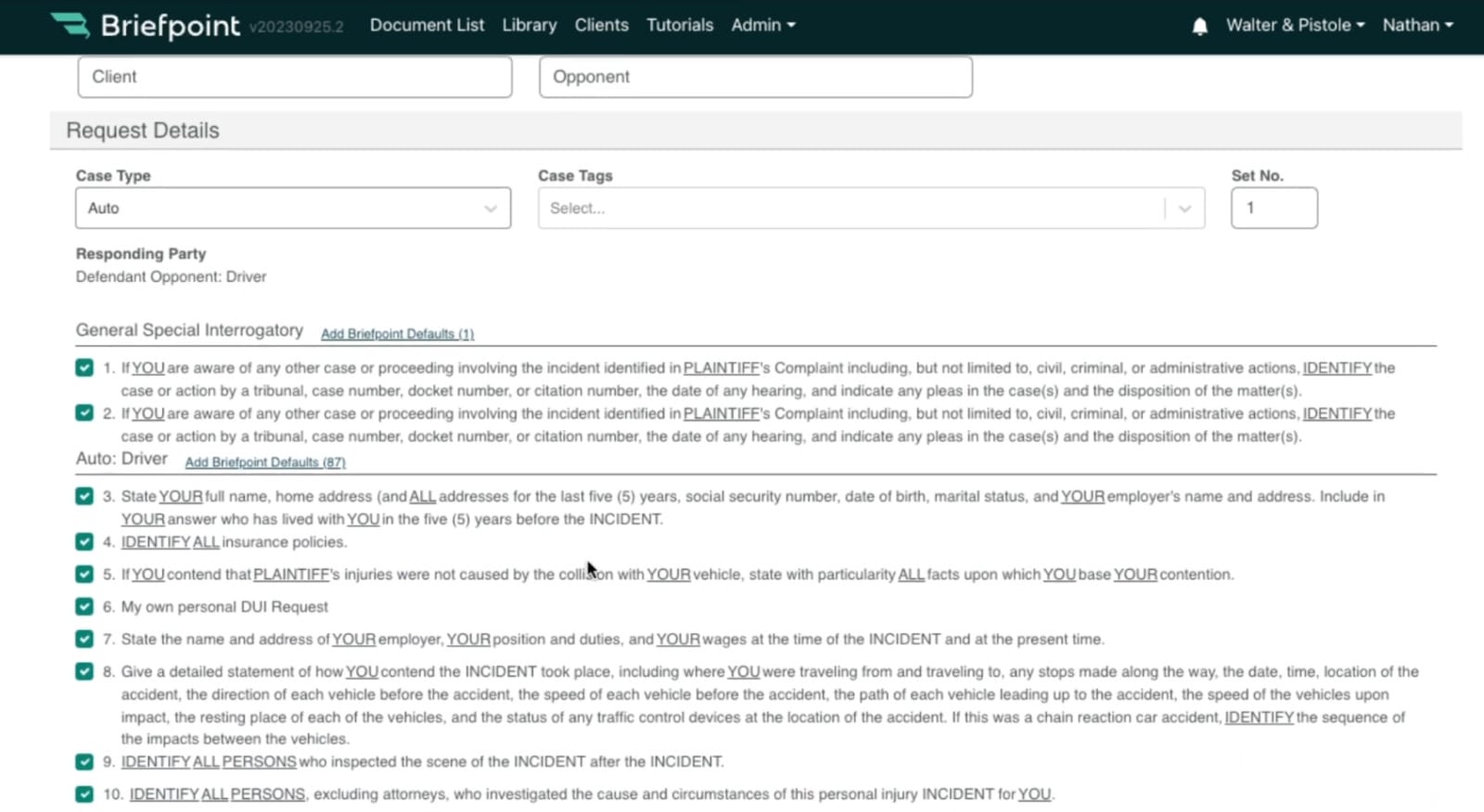
Using template libraries is straightforward. Most leading solutions let you click the item you want to include, whether sending a request to a plaintiff, defendant, or another party. That’s true of Briefpoint.
Furthermore, these template libraries include careful wording to minimize the risk of receiving a valid objection from the opposing party. For example, Briefpoint includes interrogatories such as:
Automated Drafting Tools
Automated drafting tools are another essential ingredient of top-rated propounding discovery software. These systems enable you to craft the precise document you need, depending on who you send it to and the information you request.
Briefpoint does this by taking you through a multi-choice wizard. Fillable forms give you the option to provide a short title for the case, the case number, the full title of the case, the client position (plaintiff, defendant, cross-defendant, or cross-complainant), representative action (individual, class action, or PAGA), the case type (i.e., auto, business, civil rights, etc.), the various parties’ names, and the venue.
Entering this information supplies the propounding discovery document software with the essential formatting information to proceed.
The information you must include varies between jurisdictions. However, advanced software helps you cover your bases by adding things like:
- The deadline for responding to the request
- Clear and concise statements about the requests
- Instructions on how the opposing party should format its responses
- A statement underlining the legal standing of the request
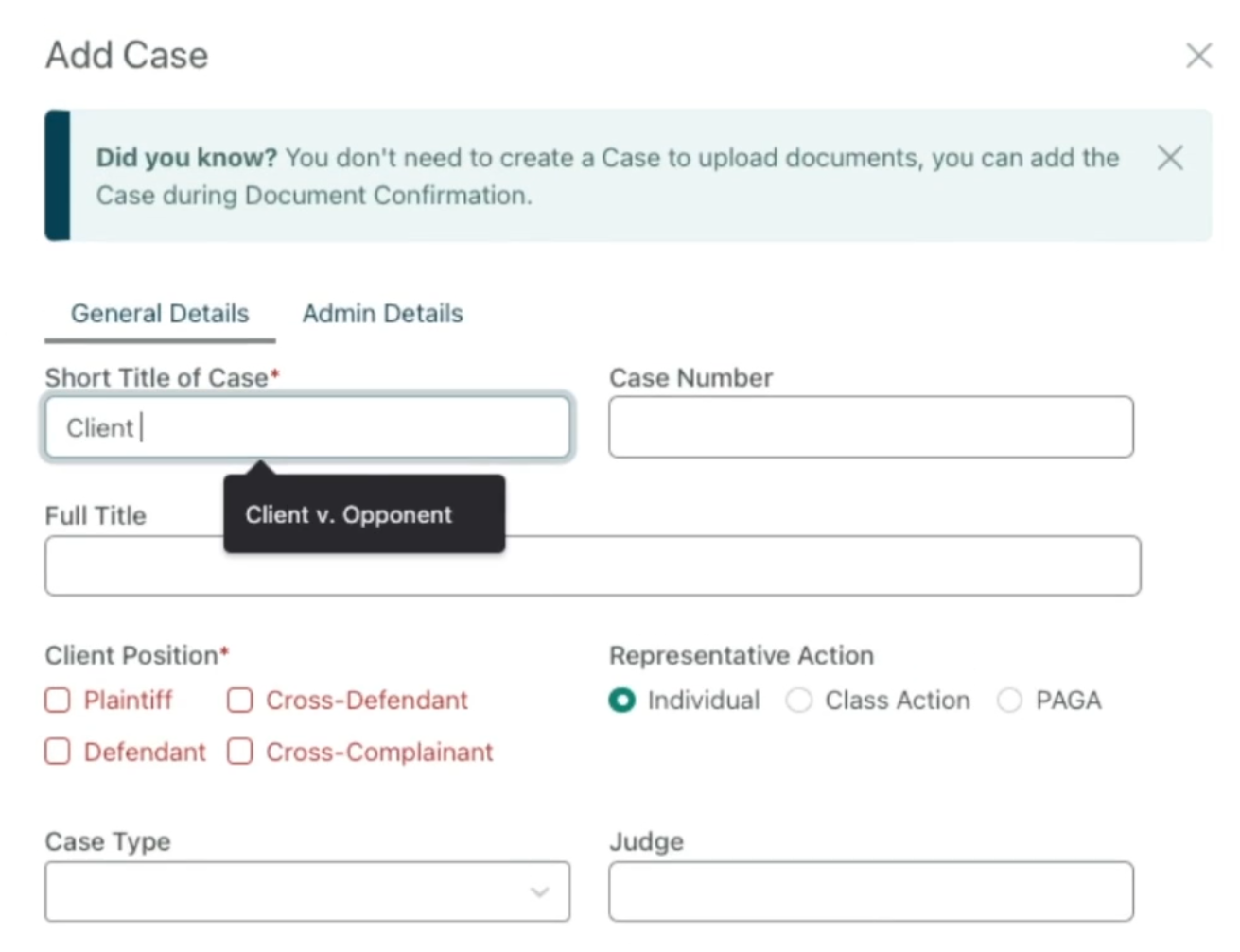
Once you add this information, the software formats it for you, regardless of the document you want to submit. The next step is to choose the request type so the software can present the proper library of pre-formatted requests discussed in the previous section.

Briefpoint lets you draft any of the following:
- Request for Admission. These requests ask the opposing party to admit or deny various “truths” or facts associated with a case. These are helpful when you want to narrow down the disputed facts and save time.
- Request for Production. These requests ask the opposing party to produce legal documents associated with the case. Any requests for paperwork must be relevant and helpful in proving your client’s case.
- Special Interrogatories. These written questions are limited to a specific topic or issue relating to the case. You might submit them to identify potential witnesses or better understand the other party’s stance on an issue.
Once you provide Briefpoint with this information, you can populate your document with specific requests. The software will format and structure the paperwork according to best practices.
Checking Compliance
Once you finish telling the software what document you want it to create, you can download it for review. (Briefpoint lets you do this in Microsoft Word.) This step allows you to check it for compliance before sending it off.
While developers take special care to make sure that template requests follow established norms and practices, you are responsible for any new items you insert or edits to existing suggestions.
Understanding How Propounding Software Can Streamline Discovery
Opposing parties can object to responding to discovery requests under certain conditions. Requests are unlikely to succeed if they:
- Are irrelevant to the case
- Are excessively burdensome
- Violate various attorney-client privileges that protect some details from disclosure
Therefore, using propounding discovery software is helpful. It reduces the risk of rejected requests, supporting your client’s case.
Briefpoint’s propounding discovery solutions are a case in point. Filing by hand is tedious, but getting our software to do it instead could save you up to 87% of your time.
You can also use it to avoid costly mistakes, such as disclosing information about your client that you shouldn’t. Responses comply with ethical rules for better decision-making.
Understanding the role of propounding software in your legal practice should enable you to make requests more effectively. You can avoid compliance issues while working in your client’s best interests.
Cut the Busywork—Power Through Discovery with Confidence
Manually handling written discovery slows your workflow and puts accuracy at risk. From document requests to special interrogatories, outdated discovery procedures make it harder to stay compliant and meet deadlines.
Briefpoint changes that. It helps you obtain discovery faster by automating the drafting process and providing court-ready templates for every stage of your case.

Ready to upgrade how you manage discovery? Book your demo today to streamline document requests and take control of your written discovery!
FAQs About Propounding Discovery
What does it mean to propound written discovery?
To propound written discovery means to formally send questions or requests, such as form interrogatories, requests for admission, or requests for production, to the opposing side in a legal matter. These are governed by the relevant civil procedure section and aim to gather all the facts and evidence needed before the trial.
What does propounding mean in law?
In legal terms, propounding refers to initiating a request for information during discovery. It often involves propounding interrogatories or document requests that the opposing party must answer with written responses and, in many cases, a signed verification.
When can a defendant propound discovery?
A defendant may propound discovery once a pending action has officially begun and procedural timelines under the applicable jurisdiction allow it. Most discovery requests—including those for sufficient information to support a defense—must comply with specific civil procedure rules and deadlines.
What does propounding party mean?
The propounding party is the one initiating discovery by sending out formal requests for information. They are responsible for ensuring compliance with discovery rules and often rely on tools like a court reporter to document responses given during depositions or other oral proceedings.
How do you respond to discovery in a lawsuit?
You respond to discovery by submitting timely written responses to each item requested by the propounding party. This may include answering form interrogatories, producing documents, or objecting to specific requests. Responses must be complete, accurate, and verified with a signed statement, especially when used as part of the evidence needed in court.
The information provided on this website does not, and is not intended to, constitute legal advice; instead, all information, content, and materials available on this site are for general informational purposes only. Information on this website may not constitute the most up-to-date legal or other information. This website contains links to other third-party websites. Such links are only for the convenience of the reader, user or browser.
Readers of this website should contact their attorney to obtain advice with respect to any particular legal matter. No reader, user, or browser of this site should act or refrain from acting on the basis of information on this site without first seeking legal advice from counsel in the relevant jurisdiction. Only your individual attorney can provide assurances that the information contained herein – and your interpretation of it – is applicable or appropriate to your particular situation. Use of, and access to, this website or any of the links or resources contained within the site do not create an attorney-client relationship between the reader, user, or browser and website authors, contributors, contributing law firms, or committee members and their respective employers.
5 In-House Legal Software Every Law Firm Should Use
5 In-House Legal Software Every Law Firm Should Use
Is your legal team spending too much time on routine tasks? If managing contracts, drafting documents, or tracking case details feels more complicated than it should, you’re not alone. Many firms face daily bottlenecks that slow down productivity and increase the risk of mistakes.
In-house legal software offers a more efficient way to manage operations. From document generation to contract tracking and billing, the right tools can reduce manual work, improve accuracy, and help your team stay organized.
In this article, we’ll walk through five essential types of in-house legal software and explore how they support a smoother, more efficient legal workflow.

Types of Software In-House Legal Teams Need
An efficient legal team doesn’t rely on manual processes alone. It uses technology to reduce friction, increase visibility, and keep everything moving. With the right tools, legal departments can spend less time on repetitive administrative tasks and more time focusing on high-impact legal work.
Below are some of the best legal tech tools that make way for smoother, faster, and more cost-effective legal operations.
1. Document Generation Tools
Creating legal documents is a staple task for any legal team, but it often consumes too much time and resources when done manually.
Document generation tools automate this process and allow faster creation of legal documents from pre-set templates.
That means you can create documents much faster and worry less about mistakes slipping through. Everything stays consistent from one file to the next.
Such tools can produce everything from routine correspondence to complex legal agreements, all while ensuring compliance with the latest legal standards.
Top Pick: Briefpoint
Briefpoint uses generative artificial intelligence to help legal teams draft discovery responses and request documents in minutes.
This platform lets you upload your discovery document, insert objections or responses, and then finish up the document in Word. Briefpoint will take care of everything in between.
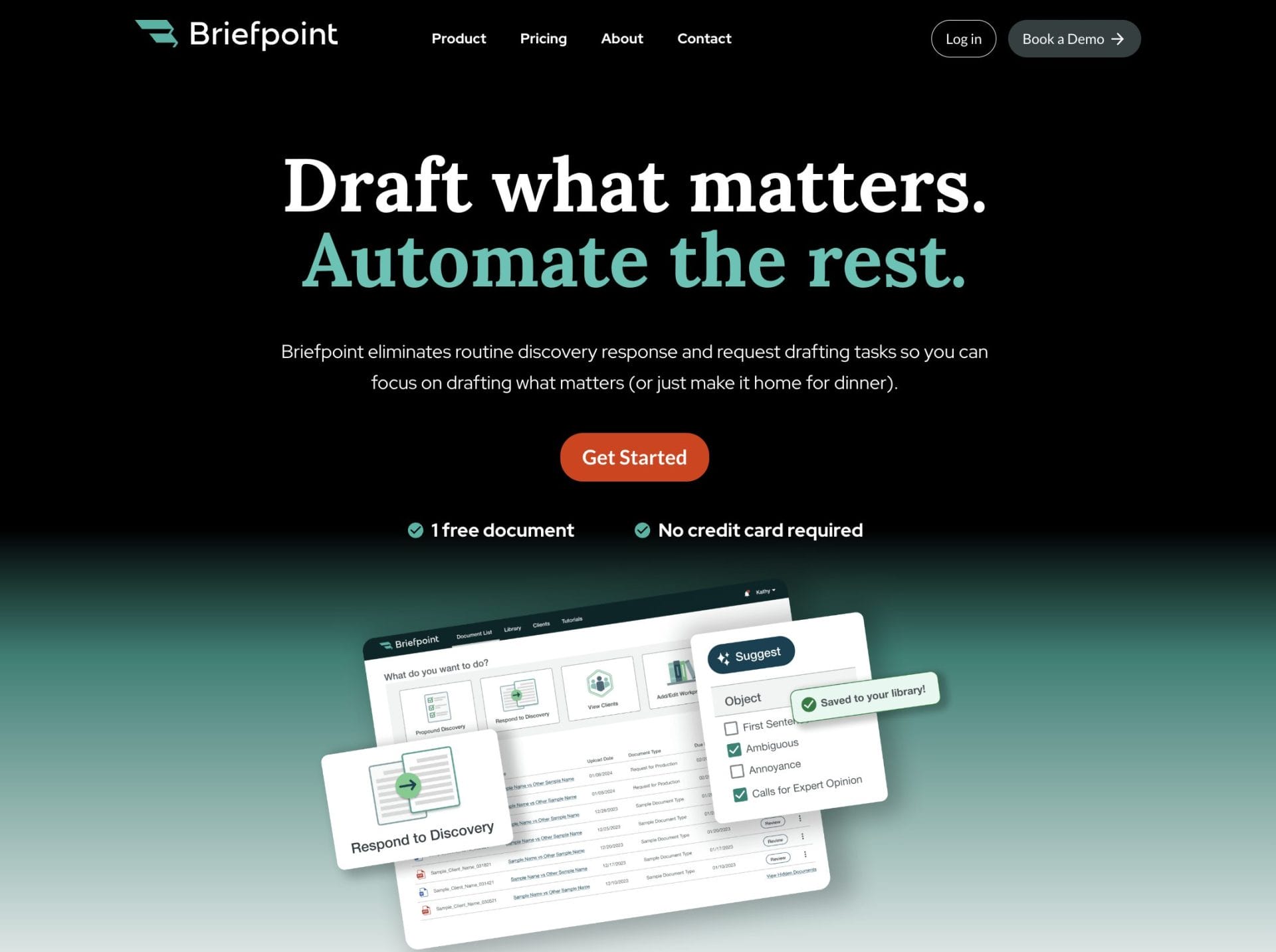
Additionally, Briefpoint’s Bridge feature makes client communication easier by converting legal terms into simple language, allowing clients to respond directly. Their responses are automatically added to your document, cutting down on the typical email exchanges.
The process is easy, even for people with limited technical skills, and it frees up attorneys to focus on other valuable tasks like consulting with outside counsel or preparing litigation strategies.
Plus, the time saved often translates to more money saved as well.
Test Briefpoint yourself by scheduling a demo here.
2. Contract Management Software
Contract workflows often slow down legal teams. For corporate legal departments managing high volumes of contracts, this isn’t just inconvenient. An inefficient contract lifecycle creates risk and delays across the business.
Contract management software brings structure to the entire process. From initial drafting and negotiation to approvals, execution, and renewals, everything lives in one place.
Built-in features typically include:
- Version control so you can track edits and see what’s changed over time
- Automated reminders to help you stay on top of key dates and approval deadlines
- Secure storage for easy, reliable access to documents without compromising security
You can also assign legal requests directly within the platform, which helps eliminate confusion around ownership and keeps legal processes moving. Instead of juggling documents over email or tracking updates in spreadsheets, your team can manage contracts with more clarity and speed.
Top Pick: Ironclad
Ironclad is a must-have for any legal department that needs to handle everything contract-related. It smooths out the whole process, from start to finish, with some smart automation tricks up its sleeve.
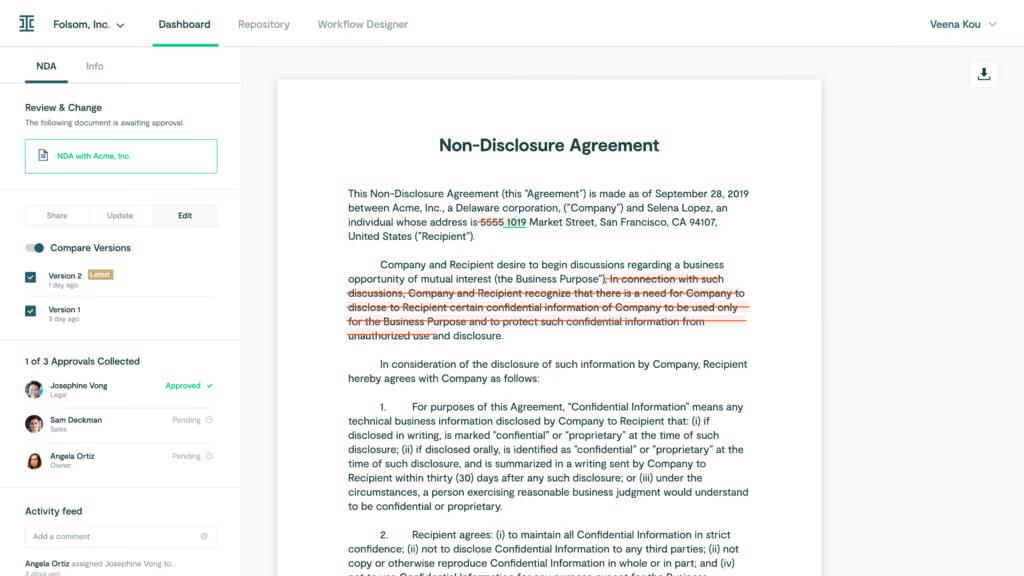
Image source: G2
Its analytics feature lets you evaluate how your contracts move through the pipeline, identify delays, and improve decision-making with real-time data.
You can also set up routing rules to assign legal requests efficiently and keep everyone aligned on the status of each document.
3. Document Management Systems
Legal operations always go hand in hand with a ton of paperwork, which is why any in-house counsel can benefit from a good document management tool.
Document management systems allow for quick retrieval, controlled access, and efficient collaboration on documents, and make sure that everything is both safe and easily accessible.
They also support data security by offering encryption, compliance controls, and audit trails, which are especially important when handling sensitive legal matters or managing contract renewals.
Legal leaders can control who sees what, track changes, and collaborate on documents without creating a dozen versions.
These systems also help automate routine tasks, like organizing files or routing documents for review, so teams can respond faster to internal clients and reduce time spent on manual admin work.
Top Pick: NetDocuments
NetDocuments is a cloud-based document management system designed specifically for legal teams. It offers secure storage, easy access from anywhere, and robust tools for collaboration and document handling.
Image source: G2
It’s known for top-notch security features and compliance with international standards, which makes it a safe bet for managing sensitive legal matters and maintaining strong data security across the board.
4. Matter Management Software
Matter management software is a one-stop shop for legal teams to keep their cases and projects in line.
It pulls together all the bits and pieces related to a case—documents, emails, deadlines, and more—into one spot that’s easily accessible through a secure platform.
It makes task management and legal workflows much easier by automating administrative tasks, keeping an eye on key dates, and making sure internal and external stakeholders are in the loop.
Legal teams also gain complete control over how matters are tracked and handled, from resource allocation to communications, helping them stay organized and responsive. As a result of the extra operational efficiency, in-house legal teams have more time to work on more complicated legal work.
Top Pick: Clio
Clio is a comprehensive, cloud-based legal practice management platform that’s really made a name for itself in the legal world for being able to streamline processes for law firms of all sizes.
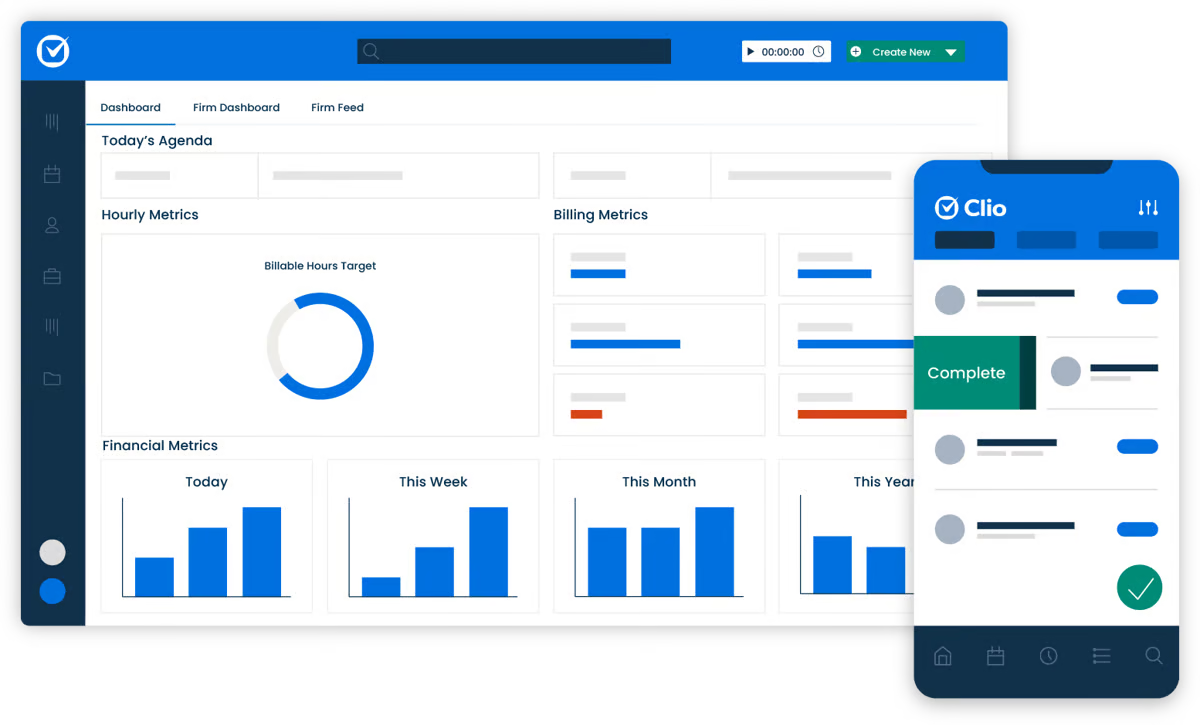
Image source: G2
With Clio, you can manage cases, track time, bill clients, and organize all your legal documents in one place.
It also has excellent features for legal intake, client communication, and scheduling, which makes it easier to keep everyone informed and on track.
Plus, Clio allows you to analyze key performance indicators with its analytics and reporting tools. This helps firms make data-driven decisions, track productivity, and identify areas for improvement across their legal operations.
5. Legal Billing Tools
Efficient and accurate billing is a must if a law firm wants to remain profitable.
Legal billing tools help you:
- Track billable hours accurately
- Manage client accounts more easily with all the details in one place
- Generate detailed invoices that follow client billing guidelines from the start
One of the key features of legal billing software is time tracking. Whether you’re working on a case, consulting with a client, or doing research, these tools make it easy to record every billable minute.
Also, they often come with functionalities to handle expense tracking and generate reports that can help guide business decisions and improve overall efficiency.
Top Pick: QuickBooks
Lawyers can leverage QuickBooks to track billable hours directly within the software, maintain accurate invoicing, and simplify the process of billing clients.
The platform also allows for the management of client trust accounts, a critical aspect of legal financial management.
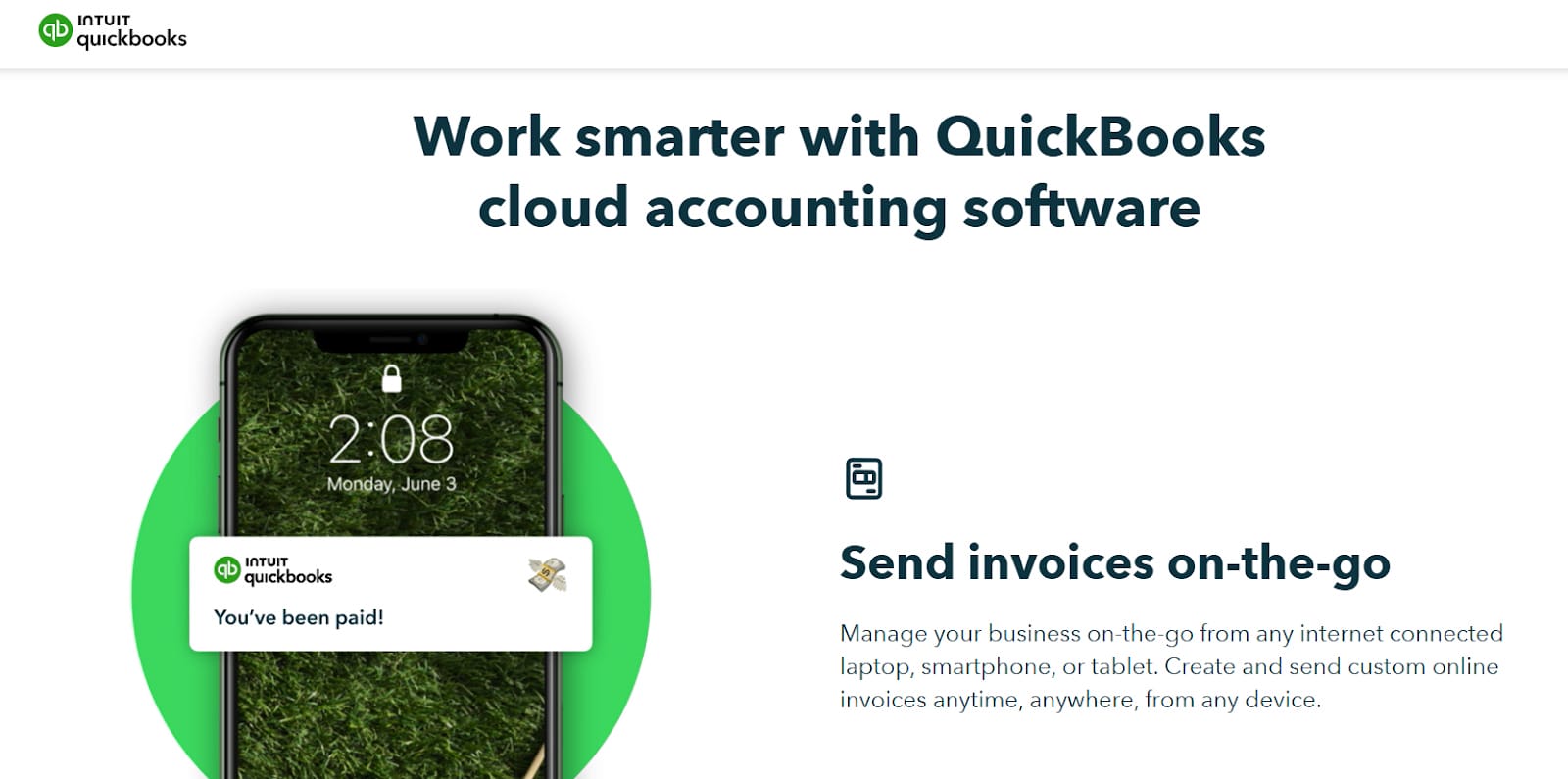
Source: QuickBooks.Intuit.com
Additionally, QuickBooks helps law firms with general accounting tasks, such as tracking expenses, managing payroll, and producing financial reports.
These features provide a clear overview of a firm’s financial health, which often leads to data-driven decisions.
Upgrade Your Productivity With the Right In-House Legal Software
Using the right in-house legal software can truly transform the way your firm operates.
From automating document creation to managing contracts and keeping everything organized, these tools make legal work smoother and more efficient.
Ready to boost your productivity? Try Briefpoint! With faster document drafting and simplified client communication, you’ll save time and reduce unnecessary back-and-forth.
Schedule your demo today and see how Briefpoint can make a difference for your team.
FAQs About In-House Legal Software
Can small legal teams benefit from in-house legal software?
Yes. Size doesn’t limit the impact of better systems. These tools are scalable and can significantly reduce the workload for small teams. They also support seamless communication and help boost efficiency across daily operations.
Is it secure to store sensitive legal documents in these systems?
Yes, with a caveat. Make sure the software complies with industry-standard security measures and data protection laws. Reputable providers prioritize data security, especially when dealing with sensitive client information and confidential legal documents.
Can in-house legal software integrate with other tools we use?
Most modern legal software solutions are built with integration in mind. They typically support APIs and offer native integrations with widely used office tools, making it easier to connect systems and maintain seamless communication across departments.
What other in-house legal software do law firms need?
In addition to the tools already mentioned, case management software is a must for law firms. It allows teams to organize case details, manage deadlines, increase team performance, and streamline collaboration so that all relevant information is easily accessible (without having to handle multiple systems). Finally, legal research software can significantly cut down the time spent on case law and regulation searches, providing faster access to relevant legal information.
The information provided on this website does not, and is not intended to, constitute legal advice; instead, all information, content, and materials available on this site are for general informational purposes only. Information on this website may not constitute the most up-to-date legal or other information.
This website contains links to other third-party websites. Such links are only for the convenience of the reader, user or browser. Readers of this website should contact their attorney to obtain advice with respect to any particular legal matter. No reader, user, or browser of this site should act or refrain from acting on the basis of information on this site without first seeking legal advice from counsel in the relevant jurisdiction. Only your individual attorney can provide assurances that the information contained herein – and your interpretation of it – is applicable or appropriate to your particular situation. Use of, and access to, this website or any of the links or resources contained within the site do not create an attorney-client relationship between the reader, user, or browser and website authors, contributors, contributing law firms, or committee members and their respective employers.
8 Best Legal Document Automation Software For 2025
8 Best Legal Document Automation Software For 2025
Legal work is filled with routine, time-consuming paperwork, but it no longer has to be.
Thanks to advances in software and AI, law firms can now automate repetitive tasks like drafting and formatting legal documents. In turn, it frees up attorneys and staff to focus on strategy, client service, and high-impact work.
But with so many tools on the market—and not every lawyer being a tech expert—choosing the right one can feel overwhelming. Many platforms promise big results, but only a few truly deliver.
This guide cuts through the noise. We’ve rounded up the top 8 legal document automation solutions for 2025, broken down by features, strengths, and ideal use cases.
Before diving into the list, we’ll quickly cover what legal document automation is and why choosing the right tool can transform how your firm operates.

What is Document Automation?
Document automation simplifies the process of creating and managing documents by using technology to handle repetitive tasks.
That means instead of drafting each document from scratch, you can rely on pre-built templates and logic to quickly produce accurate and professional results.
It’s especially useful for generating contracts, NDAs, agreements, and other essential documents that require precision and consistency.
By reducing manual work, document automation saves time, minimizes errors, and makes sure every document adheres to the same standards.
8 Best Legal Document Automation Software Tools For 2025
Looking to simplify repetitive paperwork and improve efficiency at your law firm? These top legal document automation tools offer powerful features to help you generate accurate, professional documents faster, no matter the size of your practice.
1. Briefpoint
Briefpoint is one of the leading document automation software programs specifically designed for legal practices. Over 500 law firms currently trust it to streamline the drafting of routine discovery responses and request drafting tasks, allowing attorneys to save time and focus on higher-value tasks.

As a specialized solution for the legal sector, Briefpoint automates requests for admission, requests for production, and interrogatories. These documents are time-consuming, but the document automation tool automates the process using the power of machine learning.
Simply upload your document, select your objections, download your MS Word document, and polish your draft off. Briefpoint’s AI will take care of the rest.
A standout feature of Briefpoint is Briefpoint Bridge, which simplifies client communication. This feature lets you collect client responses with ease.
It translates requests into plain English, sends them to your clients, and automatically integrates their responses into your discovery documents.
Pros
- Briefpoint significantly reduces the time spent on drafting discovery responses and other repetitive legal documents, which allows attorneys to focus on higher-value tasks
- Designed with legal professionals in mind, Briefpoint has a user-friendly interface that requires minimal training, making it accessible to users of all technical abilities
- Briefpoint is tailored specifically for the legal industry, with features that automate complex documents like requests for admission, requests for production, and interrogatories
- The platform leverages AI to scan and analyze documents and auto-populate information, which minimizes manual input and potential errors
By automating routine tasks, Briefpoint can lead to significant cost savings per attorney and improve the overall profitability of your practice.
Briefpoint lets you schedule a demo to test its software at your firm. The solution is great for people of all technical skills with almost no learning curve, saving an average of 87% of time spent on each document.
2. Clio
Clio is a market leader in law office management and offers various legal document automation features as part of a suite of services.
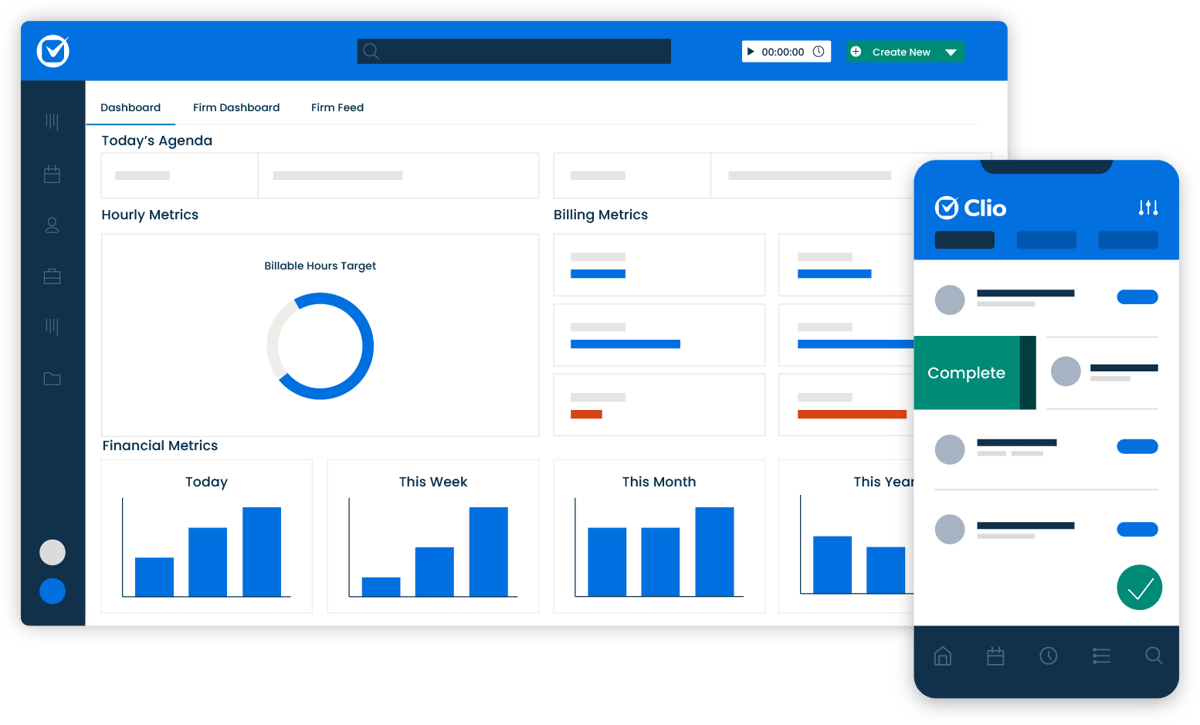
Source: G2
The platform provides a centralized dashboard for managing your practice without juggling multiple tools. It includes templates for letters, contracts, and pleadings, with a drag-and-drop editor that requires no technical skills.
Pros
- Clio combines document automation with case management, billing, and client relationship tools for an all-in-one solution
- Cloud-based platform allows access from anywhere, suitable for remote work
- Intuitive drag-and-drop interface is easy for all technical levels
- Integrates with tools like Google Workspace, Microsoft 365, and legal research software
- Customizable templates simplify legal document creation
Pricing
Clio’s pricing starts at $59 per user per month for the basic plan with features like time tracking, billing, and case management.
For teams, the Complete plan costs $169 per user per month and includes client collaboration tools, document automation, and app integrations.
3. DocuSign
DocuSign Signature doesn’t quite fall into the category of legal document automation software, but law offices use it extensively, so it is worth mentioning here.
Teams find it helpful to enable attorneys and clients to sign documents and track their progress over time. As such, it saves time compared to conventional paper-based signing workflows.
Source: G2
Other benefits include its mobile-friendliness, integration across platforms, and reasonably advanced security.
Pros
- DocuSign is user-friendly, simplifying electronic signatures for legal professionals and clients
- Widely trusted and used globally, ensuring compatibility and familiarity
- Mobile-friendly platform allows signing and tracking documents on the go
- Integrates seamlessly with Microsoft Office, Google Workspace, Salesforce, and legal tools
Pricing
DocuSign offers plans starting at $15 per month for individuals with basic e-signature needs.
For teams, the Standard plan is $45 per user per month, while the Business Pro plan, with advanced features, is $65 per user per month.
4. PandaDoc
Another piece of legal document automation software is PandaDoc. Like Clio, it is an all-in-one platform, letting you generate documents, collect e-signatures, and leverage analytics.
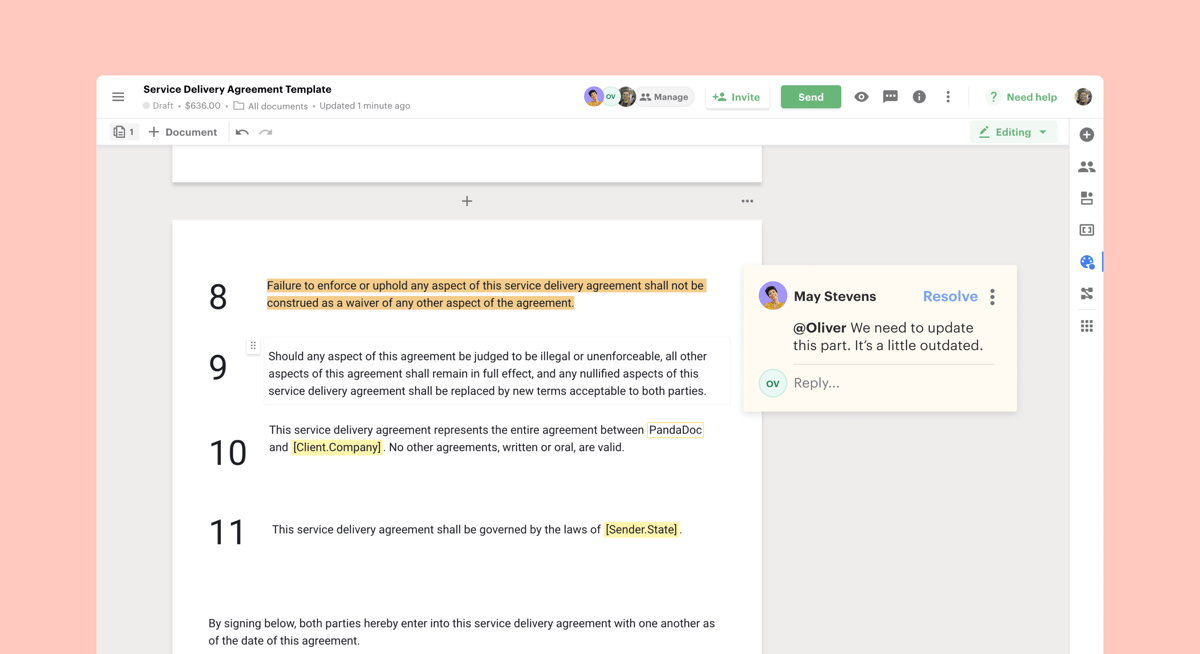
Source: G2
PandaDoc isn’t built specifically for the legal industry, but it’s still a strong contender in this space. Its robust template library and drag-and-drop editor allow law firms to streamline legal document generation and reduce time spent creating multiple documents.
The platform also supports faster contract drafting and includes built-in commenting features that simplify collaboration and help legal teams finalize documents more efficiently, especially useful in commercial law workflows.
Pros
- PandaDoc combines document creation, e-signatures, and workflow automation
- Offers customizable templates for quickly generating professional court documents
- Supports real-time collaboration for simultaneous edits and negotiations
- Drag-and-drop editor simplifies document management for all skill levels
- Integrates with CRM, payment, and productivity tools like Salesforce, HubSpot, and Stripe
Pricing
PandaDoc’s pricing begins with the Personal plan at $15 per user per month, which offers five agreements per month.
For teams, the Business plan is available at $65 per user per month. It includes features like CRM integrations, custom branding, and approval workflows.
5. HotDocs
HotDocs is also a strong contender for best legal document automation software. The tool claims that it enables law practices to process documents up to 90% faster than manual generation (including industry-standard cut-and-paste methods).
Source: G2
Again, the goal is to help you focus on your clients instead of creating tedious documents.
HotDocs is an established legal document automation software player with a proven track record and broad user base. Law offices use it for its hundreds of pre-built templates for various legal specialties and its flexibility.
The tool can also integrate with other legal software and CRMs, reducing implementation complexity. You can even use it offline, which is great for professionals on the subway or far from WiFi.
Pros
- HotDocs is a trusted document automation tool with a strong history of serving law firms, financial institutions, and government agencies
- Offers a vast library of customizable templates for various legal documents
- Automates complex documents using sophisticated templates with conditional logic
- Integrates with legal and business software like case management systems and CRMs
- Can be used offline, making it ideal for work without internet access
Pricing
HotDocs offers customizable pricing tailored to the specific needs of each organization.
6. Bryter
Bryter goes even further, claiming users can save 95% of their time on manual work with its document assembly software. The solution helps law practices automate routine document drafting, remove errors, reduce risks, and get data-driven insights.
Source: G2
Systems prevent internal clients from generating inaccurate documents while eliminating mistakes with standardized templates.
Bryter’s main selling point is its no-code client portal approach. As such, it positions itself as the brand for the average law office. The intuitive decision-tree structure and user interface mean that most professionals with experience working on computers can use it.
Teamwork is also straightforward on the automation platform. Cloud-based collaboration features enable teams of any size to work together to process paperwork faster.
Pros
- Bryter is a no-code platform that helps legal professionals automate processes without programming skills
- Features a decision-tree structure for easy creation and automation of documents and other document workflows
- Supports automation of various legal tasks, from document assembly to client intake
- Cloud-based collaboration allows teams to work together efficiently
Pricing
Bryter offers different pricing plans for its no-code platform and Bryter Extract.
7. Formstack
Formstack rounds out our list of the best legal document automation software. This established player offers solutions that eliminate paperwork, automate client documents (including personalized contract agreements and NDAs), collect e-signatures, and improve collaboration.
Source: G2
You also get security-related tools, such as controlling who can access paperwork via logic and routine tools. It also meets various legal standards, such as GDPR, PCI, and HIPAA, for any legal firm working with sensitive information.
Pros
- Formstack offers user-friendly form-building tools for legal document automation and client intake
- Automates the creation of contracts, NDAs, and agreements to reduce manual tasks
- Integrates with CRMs, payment processors, and email marketing platforms for seamless workflows
- Mobile-optimized for creating, managing, and completing forms on any device
Pricing
The Forms plan starts at $99 per month, focusing on form-building capabilities. The Suite plan, at $299 per month, includes forms, document generation, and e-signatures.
For larger organizations, customized Enterprise plans offer advanced security and tailored workflows.
8. Gavel
Gavel is a no-code platform that offers legal professionals a way to streamline document drafting without needing technical expertise. Gavel allows law firms to automate routine legal documents, such as contracts, NDAs, and client intake forms, focusing on simplicity and customization.
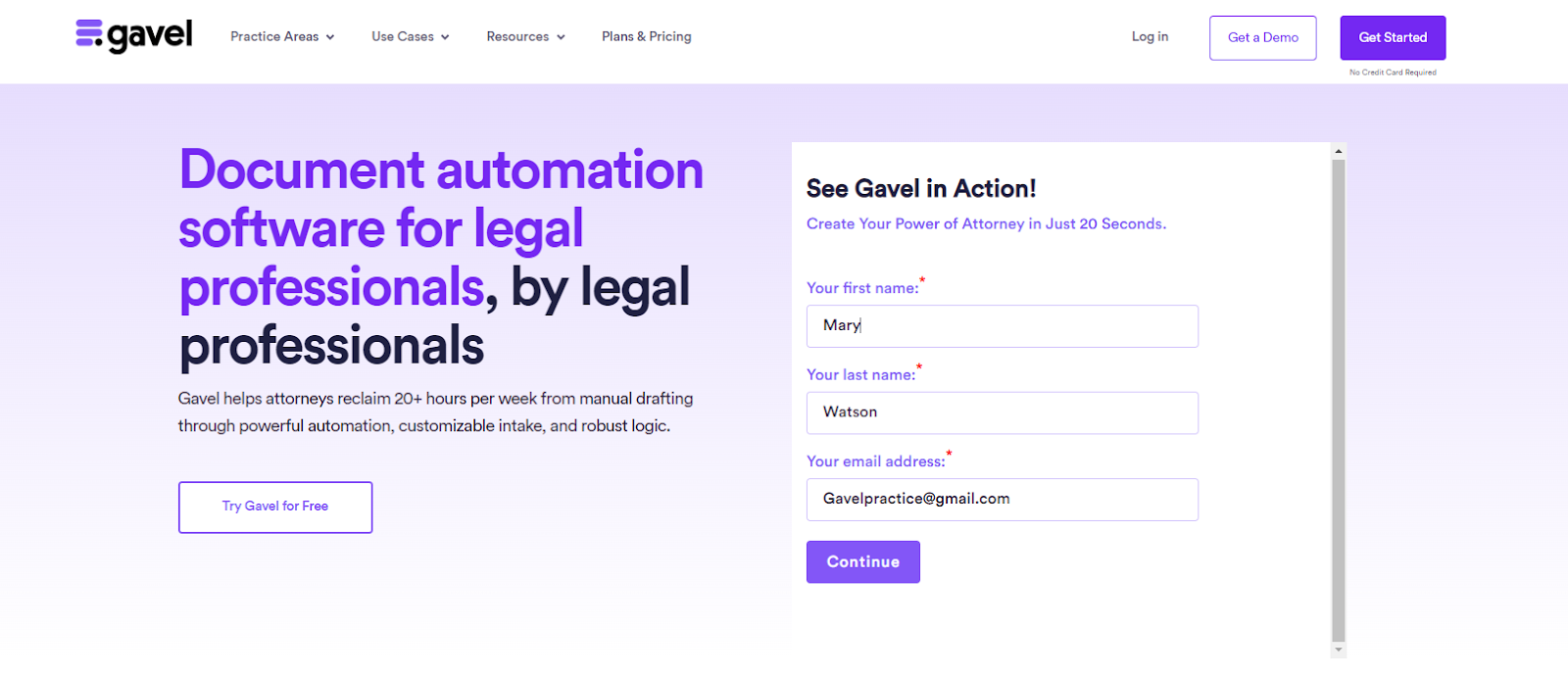
Source: G2
The platform shines with its drag-and-drop editor, which allows users to create tailored workflows and templates for a wide range of legal matters. Gavel also supports collaboration, allowing team members to work together in real time on reviewing and finalizing documents.
Its user-friendly design means that even those without technical knowledge can set up and run automated workflows with ease.
Pros
- Gavel enables document automation without coding skills and is accessible to all legal professionals
- Allows creation and customization of document templates for contracts and client agreements
- Supports real-time collaboration for efficient teamwork on documents
- Drag-and-drop editor simplifies adoption and usage for teams
- Complies with GDPR and HIPAA standards to ensure data security
Pricing
Gavel provides flexible pricing plans designed to meet various needs. The Lite plan starts at $99 per month, offering essential document automation features.
For growing firms, the Standard plan, priced at $250 per month, includes additional functionality.
Advantages of Automating Legal Documents
Automation comes with many obvious benefits, such as time savings, reduced costs, and more efficient workflows. However, it’s still worth looking into each potential advantage to see the importance of finding a solution that works for you.
Let’s explore some of the key benefits of legal document automation:
Time Savings Through Automation
Automating your legal document creation process allows you to drastically cut down the time spent on repetitive tasks like drafting, reviewing, and revising.
Instead of manually creating each document from scratch, automation tools let you generate them in just a few clicks.
This efficiency frees up valuable hours, which allows attorneys and staff to focus on higher-value tasks like strategizing, client meetings, or case analysis.
Eliminating Human Error With Increased Accuracy
One of the biggest advantages of document automation is the reduction of human error. Automated systems make sure that documents are consistent and error-free, as they pull from pre-approved templates and standardized language.
This minimizes the risk of mistakes such as typos, omissions, or incorrect information, which can be costly and time-consuming to correct.
Cutting Operational Costs For Greater Profitability
By speeding up the document creation process, automation helps reduce labor costs associated with manual drafting.
Fewer hours spent on routine paperwork translates to lower operational expenses, which can make your practice more profitable. This cost efficiency is especially beneficial for small and mid-sized firms looking to maximize their resources.
Improved Client Experience With Faster Service
With the time saved through automation, legal professionals can dedicate more attention to client needs.
Faster document turnaround times and reduced errors lead to a better client experience, improving satisfaction and potentially increasing client retention and referrals.
Maintaining Professional Consistency in Legal Documentation
Automation makes sure that all legal documents adhere to the same format, style, and standards. This consistency not only enhances the professionalism of your documents but also ensures compliance with legal requirements.
Standardized templates make it easy to maintain a uniform appearance across all your firm’s documents, reducing the need for constant oversight.
Better Security and Regulatory Compliance
Legal document automation tools often come with built-in security features like encryption and access controls.
These tools make sure that sensitive client information is protected and that your documents comply with industry regulations.
This added layer of security is a must for maintaining trust with clients and avoiding legal repercussions.
Scaling Operations With Adaptable Automation Tools
As your firm grows, the volume of documents you need to manage will also increase. Automation provides the scalability needed to handle this growth without overwhelming your team.
Additionally, many automation tools are flexible, which allows you to customize templates and workflows to suit specific practice areas or client needs.
The Best of Document Automation Tools
The legal world is changing fast, and adopting document automation software is becoming a must for law firms that want to streamline their work, cut costs, and focus more on clients.
The tools we’ve covered in this article are some of the top picks for 2025, each offering something different to meet various needs.
Whether you’re aiming to save time, maximize accuracy, or improve teamwork, there’s a solution out there that fits the bill. But with so many document automation platforms out there, finding the right one can feel overwhelming.

One tool that really stands out is Briefpoint. Designed specifically for legal professionals, Briefpoint takes care of the repetitive stuff, like discovery responses and requests for production, so you can save time and focus on what really matters: delivering great service to your clients.
Schedule a demo and find out how our document automation tech can help you save time, cut down on costs, and take your practice to the next level.
FAQs About Best Legal Document Automation Software
What are the benefits of using legal document automation software?
Legal document automation software makes life easier by speeding up the whole document creation process. Instead of spending hours drafting and revising, these tools let you whip up documents quickly, cut down on mistakes, and keep things consistent. Plus, it frees legal professionals up to focus on more important tasks, like strategizing and spending time with clients.
What is the best legal document automation software for 2025?
There are several contenders for the best document automation software for 2025, including Briefpoint. However, it all boils down to the needs, preferences, and existing workflows of your legal services. Schedule a demo with Briefpoint to see if it’s the right document automation software for you.
How does legal document automation work?
Legal document automation works by handing over composition and writing tasks to templates and AI. Drag-and-drop interfaces enable rapid document construction without creating documents from scratch or cutting and pasting from existing libraries.
What other tools does my law firm need?
Aside from document automation software, you might also need legal practice management software, billing automation tools, a document management system, and payment processing platforms, among others, to make your workflows as efficient as they can be.
Is legal document management software safe to use?
Yes. Most of these tools come packed with security features like encryption and access controls to keep complex legal documents and sensitive info under wraps. They also follow all the major legal standards like CCPA and HIPAA, so you can be confident that your client data is secure throughout the process.
The information provided on this website does not, and is not intended to, constitute legal advice; instead, all information, content, and materials available on this site are for general informational purposes only. Information on this website may not constitute the most up-to-date legal or other information.
This website contains links to other third-party websites. Such links are only for the convenience of the reader, user or browser. Readers of this website should contact their attorney to obtain advice with respect to any particular legal matter. No reader, user, or browser of this site should act or refrain from acting on the basis of information on this site without first seeking legal advice from counsel in the relevant jurisdiction. Only your individual attorney can provide assurances that the information contained herein – and your interpretation of it – is applicable or appropriate to your particular situation. Use of, and access to, this website or any of the links or resources contained within the site do not create an attorney-client relationship between the reader, user, or browser and website authors, contributors, contributing law firms, or committee members and their respective employers.
